SINGAPORE PROBES
AY 2010/2011 M.ARCH THESIS, SEMESTER 1/2 TAN BING HUI TAN EE TENG EUDORA TOH WEI CHING FELICIA DEPARTMENT OF ARCHITECTURE SCHOOL OF DESIGN AND ENVIRONMENT NATIONAL UNIVERSITY OF SINGAPORE DESIGN STUDIO ERIK G L’HEUREUX
PROFESSOR
ASSISTANT
To investigate, research and examine thoroughly. To question mindfully as an act of probing
To analyze and examine with a probe.
Singapore Probes
Singapore Probes
Department of Architecture
School of Design and Environement
National University of Singapore
Lee Foundation
ISBN: 978-981-08-9588-4
|
Erik G. L’Heureux, ed.
PROBES SINGAPORE
Singapore Probes | Erik G. L’Heureux, ed.
SINGAPORE PROBES
Tan Bing Hui
Tan Ee Teng Eudora
Toh Wei Ching Felicia
Erik G. L’Heureux AIA, LEED AP
Published by the Department of Architecture
Centre for Advanced Studies in Architecture (CASA).
National University of Singapore
4 Architecture Drive, Singapore 117566
Tel: +65 65163477
Email: akierik@nus.edu.sg
ISBN: 978-981-08-9588-4
Concept: Erik G. L’Heureux
© Centre for Advanced Studies in Architecture National University of Singapore
© Individual Contributors
All rights reserved; no part of this publication may be reproduced, stored in a retrieval system, or transmitted in any form or by any means, electronic, mechanical, photocopying, recording, or otherwise without prior written permission of the publisher.
The publisher does not warrant or assume any legal responsibility for the publication’s contents. All opinions expressed in the book are of the authors and do not necessarily reflect those of the National University of Singapore.
Thesis Advisor / Editor: Assistant Professor
Erik G. L’Heureux AIA, LEED AP
Thesis Studio:
Tan Bing Hui
Tan Ee Teng Eudora
Toh Wei Ching Felicia
Contributors:
Brenda Yeo
Michael Lee
Peter Schoppert
Siew Molly
Tan Szue Hann
Tay Kheng Soon
2
CONTENTS
INTRODUCTION
Singapore
PROBE #1: CONSTRUCT OF
Globalising
Flows in the City
Brenda S. A. Yeoh and T. C. Chang
Singapore:
3
Dreaming
Erik L’Heureux
SINGAPORE
Transnational
Singapore: Debating
Kaleidoscopic
Szue
PROBE #2: CONSTRUCT OF CITIES Density & Scale: The Way a City is Built Tay Kheng Soon Garden City: The Madness of Green Binghui / Felicia 117-147 PROBE #3: CONSTRUCT OF UTOPIA Displacing Singapore Peter Schoppert W for Wrong 149-263 PROBE #4: CONSTRUCTING VISIONS Cinepolitans: Inhabitants of a Filmic City Michael Lee Paper Architecture 263-365 4-5
or Schizophrenic? Tan
Hann
Singapore Dreaming Introduction
This book endeavors to expose and clarify Singapore through a combination of data, references, and hypotheses. Its purpose is not to provide a comprehensive historical account of Singapore nor to present a magical formula for replicating the country’s success elsewhere, as many might wish. Instead, Singapore Probes is an architectural compendium that amalgamates diverse criticisms to gain a deeper understanding of this small red dot on the equator. It aims to serve as a probing tool, allowing us to examine the city more closely and delve into its intricacies. Over the past ten years, Singapore has been my home, and this work intends to formulate, edit, and distill insights, which is especially crucial in an age inundated with vast amounts of often meaningless content.
As an architect with an interest in the overlapping realms of theory, history, technology, planning, cities, and the ideas they generate, I seek to comprehend Singapore’s inherent ideologies to inform my own design work on the equator.
Thinking through the City
This book seeks to refine critical awareness of Singapore, fostering greater sensitivity towards the city and its underlying structures, which are intrinsically ingrained in the fabric of architecture. As Diana Agrest eloquently put it, “to think of the city is to think of architecture, for the city is the limit of architecture.” When we envision Singapore as a product of 20th-century planning ideals, influenced by British colonial legacies and tropical modern typologies, we realize that it has become a model that now influences the world. Although there are other, more unplanned and irrational cities in Southeast Asia, such as Jakarta, Manila, Phnom Penh, and Ho Chi Minh, they also turn to Singapore for solutions and guidance, making it the “solution provider” for the region and beyond. Understanding Singapore means comprehending the allure that shapes policy, planning, and architecture, not just locally but globally, from China to Dubai, India to Vietnam, Malaysia to Moscow.
Critical Probes into Singapore
The probes within this book shed light on, sometimes celebrate, and often offer alternative visions as a form of criticism. This critique aims to expand the conversation, encouraging us to think about unexplored aspects or reassess the relevance of ideas from past decades. The probes in these pages scrutinize the urban ideology of high density and high-rise structures, coupled with theories of land scarcity and statesponsored capitalism, which have become the de facto model for Singapore’s success. They question whether adopting 20th-century Corbusian towers in manicured parks as prototypes is the most effective solution for a city that was once dense, wild, messy, congested, and yet full of energy and agency.
4
The probes bring to light the assumptions surrounding and the impacts of myths about density, dispersal, and atomization on Singapore’s urban form. They question the ingrained belief that economies of scale, state authorship, and deployable singular prototypes are the logical conclusions for city-making in Asia by Asians. Despite Singapore’s quantitative successes, which are often celebrated, there remain qualitative components of living in the city that need improvement, going beyond the infamous Singaporean five “C’s” -- cash, credit cards, cars, condo and country clubs.
Alternatives of Singapore
More importantly, the probes imagine Singapore as a vastly different place: an empty site or a tabula rasa that can be rethought through alternative visions borrowed from distant places, mutated, and transplanted into Singapore. From Barcelona to Brasília, from Paris to Broadacre, from cities of the past to a City of Tomorrow, Singapore becomes a mirror not only to itself but also to the cities that inspire much of its imagination. Through a series of thought experiments, Singapore is envisioned through plausible low-rise models, floating models, linear models, flat models, centralized models, fabric models, and even higher-rise object models than currently practiced. Singapore’s choice of the Corbusian towers in the park model is just one of many possibilities. To imagine architecture is to envision a city that is still in formation, a work in progress—Singapore as a place where all orders are possible.
In Complexity and Contradiction in Architecture, Robert Venturi states, “I try to talk about architecture rather than around it...by concentrating on [my] own job.” To probe into Singapore means focusing on the underlying frameworks that shape cities and architecture in Asia today. To discuss the city is to discuss architecture and what defines it. To talk about Singapore is to address our “techno” future, as alluded to in William Gibson’s now infamous article. Above all, if there is one fundamental job of an architect, it is to imagine our future.
Erik L’Heureux AIA, LEED AP Assistant Professor 2012
5
PROBE #1: CONSTRUCT OF SINGAPORE
Globalising Singapore: Debating Transnational Flows in the City
by Brenda S. A. Yeoh and T. C. Chang
1. Introduction
Transnational practices and networks of capital, labour, business and commodity markets, political movements and cultural flows are both “the products of, and catalyst for, contemporary globalisation processes” (Transnational Communities Programme, 1998). For example, transnational communities—“communities that sit astride political borders and that, in a very real sense, are ‘neither here nor there’, but in both places simultaneously” (Portes, 1998, p. 3) sustain and fuel the process of globalisation. An important site of intersection between the processes of globalisation and transnationalism lie lies in dominant ‘global cities’ of the world urban hierarchy (Sassen, 1991; Yeoh, 1999). As key nodes in the economic, social and technological networks spanning the world space economy, these ‘global cities’ are also places in themselves, where the social, cultural and economic fabric is not only woven of local elements, but involves a high density of transnational relationships as well.
In these cities, global forces must necessarily articulatecollide with distinctive local ensembles of class and culture, power constellations and patterns of state/society relations. (Oncu and Weyland, 1997, p. 1). Despite the high premium on fluidity, mobility and connectivity in the global city, Borja and Castells (1997, p. 14) further argue that cities must integrate their “local societies” because without a solid base in the citizens, city governments will not have the strength that is needed to navigate those global circuits. The global reach of the individual city in turn depends on its position as a node within networks of capital, information and telecommunications in the regional and global spheres; and its ability to innovate that is, generate and process new information and maintain “institutional flexibility” becomes critical.
The ability to confront the challenge of globalisation and global competition calls for not only positionality and expertise in capturing global networks, but also the ability to create and maintain a specific local culture of innovation and flexibility—a certain ‘institutional thickness’ (Amin and Thrift, 1992)—as well as a quality of life which will attract, maintain and develop high-quality human resources (both local expertise and foreign talent). Social anthropologist Hannerz (1993) describes four groups of people who are actively engaged in the transnational flow of culture and who, in some constellation or other, give cities their ‘global’ character. These are:
(1) ‘transnational business’, involving highwaged, highly skilled professional, managerial and entrepreneurial elites usually associated with finance, banking and business services;
(2) ‘Third World populations’, comprising lowwaged immigrants who occupy insecure niches in the unskilled or semiskilled sectors of the urban service economy;
(3) ‘expressive specialists’, who participate in the cultural scene in areas such as art, fashion, design, photography, film-making, writing, music and cuisine; and
(4) ‘tourists’, who are present in considerable numbers, attracted by the cosmopolitan intensity of the global city. Rather than a comprehensive catalogue, Hannerz (1993) intends these four categories as a heuristic device which may be useful in unpacking the transnational flows which help produce the global city.
In this paper, we have chosen to draw on Hannerz’s four groups of transnationals as our organising scheme, primarily because its range accords well with the framing of categories in local discourse in Singapore par excellence. Focusing on the way in which transnational flows of people—as embodiment of skill, talent, culture and capital — are materially and discursively drawn into the formation of the globalising city, this paper looks at the example of Singapore. Already one of the most open and networked in the world, the city has, in recent years, harkened closely to the beat of the-
8
globalisation drum in its drive to become a key global node in the region.
2. Singapore: Creating a ‘Global City’ and Sustaining the ‘Best Home’
Within the world city hierarchy, Singapore is ranked in the second tier, among those aspiring for “superleague” status. As Chua (1998, p. 995) points out, Singapore “eminently qualifies for a place in the collection of cities which are discursively grouped under [the term ‘world cities’]” having been, since its ‘birth’ during the modern age of mercantile capitalism, intensely part of global service capitalism. This has had a major influence on the cultural context in which Singaporeans understand the meaning of the nation-state in which they live. As Harper writes (1997, p. 261):
Singapore is a child of diaspora. Its history embodies many of the tensions of blood and belonging that the concept evokes. Singapore testifies to the difficulties of creating a modern nationstate on a model inherited from Europe in a region where history mocks the nationstate’s claims to cultural and linguistic exclusiveness. The post-colonial experience of Singapore has been dominated by the attempts of the state—an artifact of British rule— to surmount these constraints and to create a national community bounded by a common culture and a sense of place, and bonded by individual allegiance.
In Singapore, the construction of nationhood has been a major state-driven project since independence (Hill and Lian, 1995). The pressures of creating a nation of ‘one people’ belonging to ‘one place’, and associated manoeuvres to secure political legitimacy, build ideological consensus, discipline its industrial workforce and mould the consciousness of its new citizens have been important imperatives threaded into all major state policies— housing, education, language, community development, national service, economic development—governing various aspects of social and political life.
The current vision to secure and enhance Singapore’s position as a global city has further added a new dimension to these endeavours. Singapore’s leaders have chosen to frame the new challenges of globalisation in terms of the need to navigate between the countervailing pulls of transnationalism and localism. This is clear in the terms of reference of a high-level, Minster-led Singapore 21 Committee commissioned recently to address the challenge of, on the one hand, making Singapore a city with global reach—international, cosmopolitan and creative—and, on the other hand, “the best home for Singaporeans” (The Straits Times, 20 October 1997). The critical dilemmas of contradictory pulls of “internationalisation/regionalisation vs Singapore as home” and that of “attracting foreign talent vs looking after Singaporeans”.1 The framing of these dilemmas as irreconcilable dualisms is intended, in the words of the Prime Minister,
to drive home the point that many of these issues we face as a nation are really issues of choice … We can’t have everything that we want. We have to choose (The Straits Times, 20 October 1997).
Incidentally, the determined strategies of the Singapore government to ride the crest of globalisation and yet continue to shape the local arena demonstrates that the ongoing remapping of the world in terms of global– local tensions does not render the national arena irrelevant. Instead, as Oncu and Weyland (1997, pp. 11–12) point out,
it does not follow that national identities have now become a chimera, or that the state elite have lost the capacity to develop and pursue strategies which are contiguous with, albeit transformed versions of, older nationalisms. On the contrary, the rapid integration of national economies into global markets sets limits upon the viability of projects the state elite may initiate, but … [does not diminish] the significance of the state elite as key actors in reshaping metropolitan space [space interpreted as both material and ideological].
9
In the case of Singapore, as Yeung (1998, 1999) has argued, the state involvement in the push to venture beyond nation-state’s territorial limits is paramount, not simply through using government-linked companies as primary instruments to spearhead the regionalisation drive, but also by engaging in ‘political entrepreneurship’ through which the state opens up overseas business opportunities for private capitalists and negotiates the institutional framework for such opportunities to be tapped by Singaporean firms. Conversely, the state’s choice to pursue the strategy of global reach has been relatively uncontested in the local arena, in part because the state has generated a political discourse of survivalism and ruthless competition… which implies the deferral of political options to the global scale (Yeung, 2000, p. 145).
In this paper, we explore recently constructed and ventilated discourses and debates around the issue of transnational flows shaping the social and cultural fabric of the city, using Hannerz’s (1993) four categories as an organisational scheme. For each category, we discuss the government’s notion of best practice in drawing in and negotiating with these transnational ‘outsiders’ whose economic or social itineraries have converged, at least momentarily, in Singapore as a place.
2.1 The Business and Professional Class: Creating an ‘Oasis of Talent’
As “the most powerful manifestations of the internationalization of capital in the world space economy”, global cities distinguished by a high concentration of corporate headquarters, advanced telecommunication and R&D infrastructure and international financial services also contain disproportionately large clusters of high-waged professional and managerial expatriate workers (Beaverstock, 1996, p. 424).
In aspiring towards global city status, the Singapore state has not only emphasised building up its total business and human resource capabilities to attract transnational corporations to the city-state, but has also promoted Singapore
as a major engine of foreign direct investments into the rest of Asia through its “Regionalisation 2000” programme (a re-imaging of the city-state from “Singapore Inc. to Singapore International”) (Business Asia, 25 March 1996).
As a space of flows, Singapore’s vision involves not only drawing in elite professionals and specialists from all corners of the globe, but also becoming a springboard for venturing into the region. Another related initiative in the rhetoric of promoting Singapore as a global player is the promotion of Singapore as a ‘wired’ world city, one deeply embedded in global circuits of information flows and equipped with advanced information technology know-how. Transforming the city-state into a knowledge-based economy and information society is a key strategy in Singapore’s regionalisation drive not only to become a ‘brains service node’ for the region, but also in order to create a ‘virtual state’ in which citizens abroad can remain ‘hooked up’ to the nation (Low and Kuo, 1999, p. 58).
The corollary of these major strategies to position Singapore as a significant node in the global space of flows is the development of a highly skilled human resource base not only capacious in the “hardware” such as technological infrastructure, but also the “software—the ideas and knowledge of its people” (the words of the Prime Minister, Goh, 1999a). Besides investing heavily in information technology and human capital to meet global competition, the state has emphasised the strategy of “gathering global talent” and “making Singapore a cosmopolitan city” (Prime Minister Goh, quoted in The Straits Times, 30 August 1997). This emphasis was stated as early as in the 1997 National Day Rally, where the Prime Minister (The Straits Times, 30 August 1997) explained in some detail:
Gathering talent is not like collecting different species of trees from all over the world to green up Singapore. It is more difficult but absolutely crucial to sustain Singapore in the long term. Singapore depends on a strong core of talent, in business, government and politics. adaptable … In the information age, human talent, not physical resources or financial capital,
10
is the key factor for economic competitiveness and success. We must therefore welcome the infusion of knowledge which foreign talent will bring. Singapore must become a cosmopolitan, global city, an open society where people from many lands can feel at home.
We need strong links with every major economy, not just our close neighbours. Therefore we must incorporate into our society talent from all over the world, not just Chinese, Malays, or Indians, but talented people whatever their race or country of origin—East Asians, South East Asians, South Asians, Arabs from the Gulf and Middle East, North Americans, Europeans, Australians, even Latin Americans and South Africans. They can be businessmen, bankers, lawyers, entrepreneurs, engineers, architects, musicians, academics, technicians, or skilled workers. They will bring with them the migrant’s spirit and vigour to strive and build a better life. Our economy and society will benefit from their vibrancy and drive. Some will integrate into our society and settle here. For them we hope this spirit will eventually evolve into one of loyalty and rootedness to Singapore. But even those who do not stay permanently will make a contribution while they are here. In short, the vision is to create ‘an oasis of talent’ in the city-state which will serve as a hub for business, information and knowledge skills anchoring global networks linking the world’s three economic growth engines of Asia, Europe and the Americas (The Straits Times, 16 October 1997).
The kernels in the Prime Minister’s speech have been very quickly translated into strategic policy thrusts and implicit ‘best practices’ for Singapore. First, even during the 1997 Asian financial crisis, the state reiterated its stand that Singapore was “determined to remain open and to welcome foreign talent” (The Straits Times, October 1998). Some of the incentives put in place to attract foreign talent include fast-track employment pass applications (two to three weeks) for foreign professionals, easing restrictions on measures such as allowing foreign husbands to qualify as dependants and offering subsidised state housing to foreign professionals and skilled workers.
Other strategies include the launch of the Contact Singapore programme which involves establishing Singapore centres in major cities around the world as contact points to encourage an inflow of foreign talent into Singapore. Foreigners holding employment passes have increased from 50 000 in 1996 to about 100 000 in 1999, a considerable rate of increase comparable with the doubling in overall foreign worker population from 300 000 to 600 000 during the same period, bringing the total foreign population to 700 000 out of a total population of 3.9 million (The Straits Times, 1 May 2000).
Secondly, ‘going regional’ remains a key strategic thrust in expanding the reach of the Singapore economy even during terse periods like the 1997 Asian Financial Crisis.
Thirdly, globalising strategies of drawing in foreign talent on the one hand and encouraging Singaporeans to ‘go regional’ on the other inevitably bring into play a whole series of presences (of foreigners in our midst) in and absences (of citizens abroad) from the nation-state. As a result, not only are the spatial boundaries of the nation-state rendered permeable, the national ideology of ‘one people, one country’ needs to be recast anew to take into account new spatialities. While the project of nationbuilding and forging national identity among Singaporeans— which has been a key prong of state programmes since independence—has not been diminished, the cultivation of ‘an oasis of talent’ requires a reorientation of outlook from internal concerns to outward visions. In the words of George Yeo (1997, pp. 59–60), Minister for Information and the Arts, the mental and cultural spaces of Singaporeans need to be reconfigured:
What we need … is a culture that is outwardly oriented. What we need is a Singapore mentality that is global and cosmopolitan. This requires Singaporeans to feel secure about themselves. If we are big-hearted, we will welcome foreign talent into our midst. If we are small-hearted, we will always find reasons to be unhappy with them … If Singapore is reserved for Singaporeans alone,
11
we would have a very small Singapore. In a Small Singapore, Singaporeans who are talented would emigrate to greener pastures. If, instead, we promote the idea of a Big Singapore, then even the Singaporeans who live many years overseas would not want to give up their citizenships. The opposite would happen. Others would clamour to join our ranks. What we must strive for is a Big Singapore mentality.
These ‘best practices’ to globalise the citystate have been the subject of public discussions in the press as well as in forums spearheaded by the Singapore 21 Committee. The need to welcome more foreign skilled workers into the country to fuel the engine of growth has generated considerable debate as to whether migrants will “make the pie bigger or take away the icing” (The Straits Times, 30 August 1997). Proponents argue that the logic of importing talent is “irrefutable” given that Singapore’s small size will never produce enough to maintain a competitive edge in the face of escalating regional and global competition. The strategy is to “draw foreigners to help us compete against others” (The Straits Times, 16 October 1997), erasing the divides between nationalities to fuel the competition between places. Others point to the country’s roots as an immigrant society, extending the argument either historically by locating Singapore’s success in the ancestral genealogy of “immigrant forefathers” on whose toil the country was built, or by pointing to the number of former non-Singaporeans (i.e. ‘immigrants’) who now hold leadership positions in various fields in Singapore society (The Sunday Times, 27 July 1997).
According to a newspaper survey (The Straits Times, 6 June 1998), while most (76 per cent) Singaporeans supported “the Government’s drive to bring in talent from abroad while encouraging local firms to go regional” on the grounds that it will “bring economic benefits” and make Singapore “more exciting culturally” and “ more interesting to live in”, a minority (23 per cent) were against the policy for fear of economic, social and political problems.
It has been argued that the onslaught of alien values will fray the country’s social fabric; competition for space and amenities will heighten; and that policies intended to attract such talent will result in preferential treatment of noncitizens. Citizenship will not only lose its advantages, but citizens will lose out altogether. Furthermore, if foreigners admitted are mainly skilled workers able to command high salaries, there will be no room for the local population, especially “those stuck permanently at the bottom” of the socioeconomic ladder (The Straits Times, 30 August 1997). In short, not only would expatriate workers with skills and qualifications bring competition right to the doorstep at a time when Singaporeans are losing jobs as a result of the Asian crisis, incentives to woo foreigners would erode, if not obliterate, the difference between citizens and non-citizens. In particular, some have argued that “foreigners” who become Permanent Residents enjoy “all the privileges of citizenship and none of the responsibilities” (The Straits Times, 27 June 1998).
2.2 Unskilled Immigrant Workers: The ‘Underbelly’ of Global Cities
To date, ‘foreign talent’ which deserves a place in Singapore society is defined primarily by their ability to fill particular economic niches— that is, they must be “the right kind of people who can contribute to our economy” (Wong Kan Seng, Minister for Home Affairs, quoted in The Straits Times, 13 September 1997). The government has been careful to add that this call to absorb ‘foreign talent’ to create a more creative, cosmopolitan Singapore is not tantamount to opening the floodgates, but will be a highly selective process. Of the categories of foreigners to be brought in to fill the gaps identified in government pronouncements, selectivity is also exercised in terms of the degree of permanence accorded to each group. At the bottom of the pecking order, unskilled workers such as domestic workers and construction workers are relegated to the most transient of categories—work permit holders— subject to the ‘use and discard’ philosophy. In the words of Wong Kan
12
Seng, Minister for Home Affairs, these are “low skilled workers … they only come here to earn a decent living, go home and have some savings for their family”, thus obviating the need to create any form of social support facilities which may encourage a more permanent presence (The Straits Times, 13 September 1997).
However, it must be noted that the global city is not only a crucial node in the development of new geographies of skilled professional and managerial workers (Findlay et al., 1996), but also is sustained by low-skilled, low-status migrants, the new ‘helots’ in Cohen’s (1987) words, who service the needs of the privileged in both residential and commercial settings (Sassen, 1991). Indeed, it has argued that low-waged immigrant- sector labour is not a residual category in the economy of the global city, but a basic precondition, enmeshed in processes which represent “the under-belly of globalisation” (Chang and Ling, quoted in Stasiulis and Bakan, 1997, p. 121). As earlier noted, the number of foreign workers (the term usually applies to the unskilled and semi-skilled as opposed to ‘foreign talent’ which is reserved for the highly skilled) had escalated at the same rate as skilled expatriate workers. State policy with regard to foreign workers is conceived to ensure that they are no more than a transient workforce, “a buffer to even out the swings of the business cycle” (The Straits Times, 17 November 1988) and subject to repatriation during periods of economic downturn. To dampen the rising demand for foreign workers, stringent legislation has been put in place not only to restrict their number and ensure their shortterm migrant status, but also to govern their employment.³
First, all employers of foreign workers must pay a monthly levy, which has risen rapidly over the past few years to stand currently at S$345 for a domestic worker and S$470 for a construction worker. A second mechanism through which migrant workers are regulated is through a stringent allocation system which also puts the onus of responsibility surveillance to ensure acceptable behaviour by the workers on the employers as
opposed to the state. In the case of domestic workers, allocation is based on criteria such as employers’ household income and, for second maids, adequate justification in terms of the need for care-givers for children, invalids or the elderly. For foreign maids, 2-year work permits are normally renewable up to a maximum of 8 years; renewals after 8 years of employment in Singapore are considered on a case-by-case basis. The work permits are issued on the condition that the women do not marry Singaporeans or become pregnant; furthermore, they must undergo a 6-monthly medical check-up to test for pregnancy and venereal diseases. Every employer is required to pay a security bond of S$5000 to the government; the bond is forfeited should the maid fail to comply with any of the conditions.
Since 1 March 1997, employers are also required to purchase a personal accident insurance policy of at least S$10 000 for the maid (with beneficiaries being the maid or her next-of-kin) (The Straits Times, 24 January 1997). In the case of construction workers, the government has expressed concerned over the low productivity of the construction sector and its heavy dependence on foreign workers. It has recently introduced a package of measures aimed at reducing the demand for foreign construction workers. This includes legislation for ‘buildability’ for construction projects (measured by efficiency and labour productivity) as a requirement for building plan approval and a new work permit allocation system whereby permit entitlements are given to main contractors. Main contractors will then manage allocations to sub-contractors and undertake to provide accommodation and find alternative employment for foreign workers abandoned by sub-contractors. Employers found to have abandoned their workers would also forfeit the security bond of S$5000 for each worker while those who have defaulted on levy payments would forfeit an additional security bond.
Clearly, much of the state rhetoric about the creation of a cosmopolitan society with a ‘Big Singapore mentality’ which welcomes foreigners is not intended to be all-encompas
13
passing. There are definite limits to cosmopolitanism in Singapore’s vision of a global city. To date, public discourse on foreign workers has focused on issues such as the social problems of foreign worker enclaves and the impact of maids on the Singapore family (The Straits Times, 16 July 1998) rather than their incorporation into the social fabric of the global city. In the case of domestic workers who are sequestered in the confines of their employers’ homes for most or even all days of the week, their exclusion from the material spaces in the public sphere … also signals the lack of a foothold on the metaphorical spaces opened up in recent public discourse on potentially more inclusive notions of citizenship and civil society (Yeoh and Huang, 1999, p. 1164; see also Yeoh and Huang, 1998).
2.3 Tourists: Visualising a Tourism Capital
A third category of transnational people are tourists. Singapore’s quest to be a global tourist centre is encapsulated by the STB’s (Singapore Tourism Board) vision to develop Singapore as a ‘tourism capital’ (STB, 1996a). The STB explains that all great cities acquire the status of a ‘capital’ by exerting their hegemony in fields like finance, business, communications, fashion and religion. In the new millennium, Singapore aspires to a pivotal position in tourism by serving three roles: a destination for visitors, a location for tourism investments and a tourism gateway to south-east Asia (STB, 1996a, p. 4). To be a tourism capital, three interrelated ‘best practices’ are undertaken requiring Singapore to redefine its urban and tourism planning philosophies and realign its regional policies. The first best practice is to redefine the very parameters of ‘tourism’. In the new millennium, tourism will refer not only to the business of attracting visitors, but also attracting capital and entrepreneurs to invest in the country. Although it has successfully served as a destination for over three decades, Singapore’s tourism future is less assured because of regional competition and local resource constraints. An ambitious plan is required where economic wealth is generated not just through the capricious flows of visitors,
flows of visitors, but also through stable investment streams. Transnational flows of visitors are therefore to be augmented by the transnational flows of capital, expertise and corporate elites. Singapore is thus to be developed as a destination, tourism business centre and tourist hub.
The redefinition of tourism to include ‘investments’ as well as ‘people’ has implications for local urban planning. A second best practice, therefore, is to reconfigure Singapore’s tourism base to be dually attractive to visitors, investors, capitalists and tourism-related enterprises. To make Singapore both “visitable” and “investable” (Kotler et al., 1993, p. 2), the urban environment will have to develop what Zukin (1995) calls symbolic landscape cues of urban vivacity and cultural dynamism. In the light of this, the STB has outlined a wide-scale urban enhancement scheme in which 11 “experiential themes” were selected to accentuate Singapore’s cultural and aesthetic resources, while also focusing urban redevelopment in strategic sites. For example, the “Night Zone” theme highlights the need to develop Singapore’s nocturnal food and entertainment spots, while “Ethnic Singapore” emphasises the importance of multicultural diversity through the revitalisation of Chinatown and Little India (STB, 1996a, pp. 30–31). A total of S$300 million has been committed to thematic development over the next 4 years (Property Review, 1998, p. 21).
Developing a tourism capital also entails repositioning Singapore’s role in the regional urban hierarchy. In this third best practice, the STB adopts a transborder tourism approach by “going beyond her physical boundaries, to participate in the growth of the Asia Pacific region” (STB, 1996a, p. 17). Through this strategy, Singapore will no longer be just a beneficiary of tourism inflows, but also its primary generator.
The transborder approach encourages businesses in Singapore to expand to the rest of southeast Asia and it also encourages visitors to travel to neighbouring locales after visiting Singapore. As the gateway to the region, Singapore positions itself as a primal node in the regional hierarchy of south-east Asian cities.
14
node in the regional hierarchy of south-east Asian cities. Presently Singapore hopes to harness its strengths in air and sea port development to serve as a cruise hub for the region (Kumar and Lee, 1991; Peisley, 1993). By attracting international visitors to south-east Asia via Singapore, the city-state benefits from the influx of cruise tourists as well as the chance of becoming an investment centre for cruise- and shipping-related companies (Hsu, 1995).
Singapore’s tourism best practices above are cogently summarised by the STB’s stated intentions to “redefine tourism”, “reformulate the tourism product” and “reconfigure new tourism space” (STB, 1996a). However, we argue that this vision of a tourism capital is highly contested and that there are inevitable challenges to be considered. First, the notion of urban thematic development has been negatively perceived as a form of tourism promotion rather than as an avenue to enrich Singaporean lifestyle. Indeed, thematic enhancement is not a new phenomenon as witnessed by past conservation efforts in the Civic and Colonial District in the 1980s. Much of the fruit of earlier thematic programmes has been the subject of research, and a disconcerting finding from these studies is that both tourists and Singaporeans feel the government’s efforts have been mainly dictated by tourist demands. This has resulted in elitist landscapes devoid of a local sense of place (see, for example, Kong and Yeoh, 1994; Teo and Huang, 1995; Chang, 1996, 1997).
Recent debates on the STB’s proposed plans for a revamped Chinatown exemplify deepseated antagonisms towards tourist-linked projects. Unveiled in 1998, the STB’s plans to create themed streets (such as Food Street or Tradition Street); elemental gardens (featuring the five elements of Chinese mythology); and a village theatre featuring staged operas and performances have been vociferously attacked in the press and public forums for creating an Orientalist caricature of Chinatown, sanitised for foreign consumption. Against an upswell of local criticism, the STB was forced back to the drawing-board to reconceive a blueprint that speaks directly to Singapore’s immigrant Chinese past
blueprint that speaks directly to Singapore’s immigrant Chinese past. Under its new plans, the elemental gardens have been erased and an interpretative centre celebrating the stories of the local inhabitants— including disenfranchised coolies and immigrants—will be constructed. The STB explains that the new Chinatown will be a “magnet for locals” and ongoing consultations with the public will be conducted to ensure that the place “delivers an experience that is authentic and heartfelt for Singaporeans and residents here” (cited in The Straits Times, 29 December 1998). This approach of consciously integrating local needs in tourist projects must similarly inform the development of other thematic sites like Pulau Ubin and Little India in order to be accepted by Singaporeans (Begam, 1997; Chang, 2000).
Secondly, Singapore’s ambition to be a tourism gateway presupposes an unchallenged hegemony which is clearly not the case given the tourism– politics of the region (Low and Toh, 1997; Chang, 1998). Rival cities like Kuala Lumpur and Bangkok, and those afar like Hong Kong, are investment centres in their own right and compete aggressively as spatial sponges for tourism investments. For example, under its ‘Amazing Thailand’ policy, one of Bangkok’s professed roles is to be a tourism gateway for Indo-China. Bangkok is already a popular investment node for travel-related companies with investments in Cambodia and Vietnam, and its central location along international air routes rivals Singapore’s as a transport hub. With the opening of new airports in ‘secondary cities’, alternative gateways are constantly being churned up in the forms of Kuala Lumpur, Macau, Hong Kong and Bangkok (Bailey, 1996). Indeed, Singapore’s quest to be a nodal city in the urban regional hierarchy is highly contested because of the constant threat of ‘dehubbing’ by rival localities, and the fluctuating fortunes of neighbouring countries.
The challenges sketched above compel us to acknowledge the local repercussions of Singapore’s global tourism ambitions. The desire to attract tourists to the country and to serve as a gateway to the region certainly engenders widespread transformations of local landscapes and a reconfiguration of Singapore’s position in the regional hierarchy of cities.
15
and to serve as a gateway to the region certainly engenders widespread transformations of local landscapes and a reconfiguration of Singapore’s position in the regional hierarchy of cities. As a tourism capital negotiating the transnational flows of people and capital, the Singapore state must be prepared for the challenges of regional competition from other would-be tourism capitals, as well as the voices of dissent emanating from the grassroots. Reconciling local and regional tensions with Singapore’s international ambitions becomes an imperative in a globalising city-state.
2.4 Creative Specialists: Creating a Symbolic Economy through the Arts
The STB’s goal of attracting tourism investments constitutes only one aspect of the EDB’s (Economic Development Board) larger goal of spearheading a ‘lifestyle services cluster’ in Singapore. According to EDB, five sectors constitute this cluster:
(1) tourism and leisure services;
(2) the arts;
(3) media services;
(4) medical services; and
(5) education services (EDB, 1995, p. 34).
The aim is to develop Singapore as a ‘global city with total business capabilities’ in tertiary sectors while simultaneously promoting the ‘softer aspects’ of life. These ‘software’ businesses serve as a form of ‘cultural capital’ which imbues places with an image of social vibrance and a high quality of life (Bianchini, 1991; Zukin, 1995). Developing a thriving cultural industry is also key to fulfilling the symbolic function of projecting the country multifariously as a global city, an exciting tourist destination, a viable investment venue and a good home in which to live. Three interrelated best practices are implicit in Singapore’s quest to cultivate a creative lifestyle industry.
The first best practice is to market Singapore as a ‘Global City for the Arts’, targeting sophisticated cultural tourists. In an era of niche marketing and tourism specialisations (Poon, 1989), arts tourism allows Singapore to focus on a particularly high-yield and long-staying
(Poon, 1989), arts tourism allows Singapore to focus on a particularly high-yield and longstaying market, a niche group which futurologist John Naisbitt (1990, cited in Kotler et al., 1993, p. 327) predicts will become the world’s largest leisure consumers. Towards this end, many arts attractions and events have been staged in Singapore such as Tresors—the International Arts and Antiques Fair; Broadway productions of Cats, Phantom of the Opera and Les Miserables; as well as popular entertainment events ranging from DisneyFest to pop, jazz and new-age music concerts. Marketing these events regionally has attracted Malaysians, Indonesians and other Asian tourists. For example, tourist presence at Phantom of the Opera contributed S$1 million in revenues alone (The Peak, 1997, p. 98) while Tresors 1996 attracted 50 tourist ‘arts packages’ constituting 200 hotel room nights (STB, 1996c, p. 38). Capitalising on Western art forms, Singapore hopes to attract a burgeoning Asian market by providing an alternative to Western cultural hubs such as New York and London.
Apart from targeting tourists, a second best practice is to develop Singapore as an arts business hub. Replicating its successful hub concept in manufacturing, finance, transport and communications, a similar ambition is envisioned for arts and culture. Hence, new incentive schemes, subsidies and infrastructure have been developed to fuel the arts as a source of jobs, revenues and investment (EDB, 1995; STB, 1995; Rajendra, 1998). Education in the arts was revised in 1998 to produce practitioners to meet the labour needs of the nascent industry (The Straits Times, 21 September 1998). Ambitious plans have been drawn up to develop new venues for the performing arts, museums and galleries.
The third but perhaps least obvious best practice is the EDB’s deployment of the arts as a vehicle to negotiate transnational communities. This negotiation process takes two forms: attracting global talent and retaining local community. On the one hand, the arts function as a cultural magnet to attract all forms of foreign expertise, expatriates and talents to work and live in Singapore. This includes creative specialists as well as foreign talents in other sectors lured by Singapore’s vibrant cosmopolitan
16
talents to work and live in Singapore. This includes creative specialists as well as foreign talents in other sectors lured by Singapore’s vibrant cosmopolitan ambience. On the other hand, a lively cultural scene also serves as a social glue, retaining local residents by offering an improved standard of living rivalling the best of other global cities. The ‘global city for the arts’ vision therefore fulfils economic goals and socio-political agendas. In an era where people flows are as fluid as capital flows, the cultural industry takes on the symbolic role of “strategic place marketing” to satisfy the needs of its key constituencies comprising citizens, investors and workers, as well as to attract potential new businesses, tourists and residents (Kotler et al., 1993, p. 18).
The material bases of Singapore’s cultural production have provoked two main strands of local debate. The ‘symbolic economy’ of the arts is criticised because the arts and culture are being nurtured in Singapore for their economic worth rather than for their own intrinsic value. For example, the concept of arts hubbing emphasises massive infrastructural development, the import of foreign cultural specialists and recognises the needs of tourists. The benefi. ts to local practitioners and experimental arts groups, and the attention to smaller-scale development projects are less visible. A vocal critic of the hubbing concept is T. Sasitharan, then Artistic Director of The Substation who explains (cited in Rajendra, 1998, p. 10):
The hub model works for sea and air ports. It will not do for culture and the arts. It will retard the growth of our indigenous arts development and in the long run will be detrimental to Singaporean artists. Adoption of the hub model has led to the development of infrastructure over the development of manpower and skills—it emphasises hardware over software. And I believe it will not be sustainable.
One example of hardware emphasis is The Esplanade—Theatres by the Bay, which is the most expensive infrastructural development in the arts. To be completed over several phases from 2001 onwards, The Esplanade comprises several theatre and performance spaces costed about own intrinsic value. For example, the concept of arts hubbing em
performance spaces costed about S$6400 million. This massive undertaking reinforced the country’s keen interest in hosting hallmark events and foreign entertainment acts, but locals questioned the benefits that Singaporean practitioners would enjoy. Emphasising infrastructure (‘hardware’) without a concomitant cultivation of local manpower (‘software’) would run the risk of developing a city with all the trappings of a global hub but without a bedrock of local talent to fuel the ambition. Jonathan Benavides, Director of Andres Contemporary Art, had this to say of the government’s mindset:
I think the problem in Singapore is that they [the government] see art as trade, the way you see watches, furniture or plants. So, it’s just a trade and everything goes through the same procedure and I think that’s wrong; that’s wrong because art is culture. I always think Singapore is like a human body that is done up—all the buildings are there, the money and the infrastructure and the security and so forth and then the arts come to fi. ll a part of this body. And I think that’s one of the problems; the art business is not the same as selling watches (personal interview, 12 March 1998).
Cynics regard The Esplanade as the government’s way of boosting the arts scene by attracting blockbuster foreign acts rather than providing a seedbed for home-grown artistes. For example, the cancellation of plans to build the smaller theatres, according to Guarav Kripalni General Manager of Singapore Repertory Theatre (SRT), is an unfortunate slap in the face for local arts practitioners:
It is a shame that they [the government] scrapped those smaller theatres, as they are needed to build up a vibrant local arts scene. So what you have now is the 2,000 seat auditorium. How many local theatre groups can fill a 2000 seat auditorium? SRT and maybe Action Theatre. Of these two and only over an extended period of time can we fill the 2000 seat auditorium. SRT can only do this once or twice a year. We need to do smaller shows the rest of the time because of our budget (cited in Lee, 1999, p. 26)
17
The rush to develop Singapore as a global city for the arts has therefore prioritised mega events, hallmark infrastructure and the ‘borrowing’ of international artistes. More must certainly be done at the grassroots level to stimulate local talent and to provide modestly scaled infrastructure. Cynics, however, question whether “a vibrant arts scene could ever be the result of government blue-prints” and whether an artistic society can be fostered through an economics-driven programme of change (Harvard Asia Pacific Review, 1996/ 97, p. 80). It has also been questioned whether the current climate of liberalisation is the outcome of social progress or simply a knee-jerk response to the exigencies of tourism promotion and capitalist accumulation (The Substation, 1996).
The goal of developing Singapore as a cultural and entertainment capital peopled with creative talents, tourists and skilled migrant workers has certainly raised important questions of local identity in a globalising city-state. Indeed, the quest to embrace Western art forms and entertainment events as part of Singapore’s cultural resource base has prompted many to question the place (or lack thereof) of Asian arts and creative expressions in the country. The desire to promote Western art forms may run the risk of marginalising local talents, rendering Singapore as a global city for the ‘borrowed arts’. In its quest to be a global cultural hub, local best practices must be questioned anew and realigned along international standards. The direction taken by the government to liberalise is a prudent first step, but more should be done to give creative specialists a freer hand to shape Singapore’s cultural and artistic landscape (Sasitharan, 1996).
3. Conclusion
As Singapore aims to be a ‘global city’ as well as the ‘best home’ for its citizens, the tensions between its global aspirations and local assertions have to be constantly renegotiated. Amidst these negotiations, the Singapore state has been active in the forging of a vision for the future (often acronymised as ‘Singapore 21’) which continues ‘the Singapore story’ (a catchphrase which encapsulates another state
as ‘Singapore 21’) which continues ‘the Singapore story’ (a catchphrase which encapsulates another state construction tracing Singapore’s trajectory of success from the past to the present) into the new millennium, envisaged as an age which brooks no retreat from the forces and consequences of globalisation. To position the city as an international hub for business, information and knowledge, as well as a springboard for venturing into the region, Singapore’s economic architects have developed a concerted effort to augment the pool of transnational talent. This includes both foreigners and Singaporeans who are equipped to respond to globalising and regionalising forces with the finesse of navigating between being ‘home’ and ‘away’ at the same time. Global cities, however, are not constituted solely by transnational elites; instead, the growth of the managerial and professional labour-force is predicated on the lowwage service and manufacturing jobs that service the expanding, highly specialised service sector (Sassen, 1991, p. 315).
While this is so, fears of the ‘peripheralisation of the core’ have meant that globalising cities such as Singapore have introduced stringent, finely calibrated policies regulating the inflow of low-skilled transnational migrants on a ‘use and discard’ principle. Singapore’s best practice in tourism has been to redefine the very parameters of ‘tourism’ such that both visitors and investments are being catered for. The planning implications are multifold as ‘strategic tourism marketing’ is no longer confined to beautifying the city, but also provides the requisite infrastructure to facilitate capital investment and wealth creation in the region. In the area of culture, Singapore aspires to be a ‘global city for the arts’. An economistic approach is adopted, deploying culture as a multipurpose tool to attract niche tourists and skilled talent, to develop new service sectors and to upgrade the quality of lives of Singaporeans. The planning implications have been to develop the cultural infrastructure, to market Singapore as a pleasant place in which to live and work and to realign local rules of governance in tandem with international standards.
18
As mentioned earlier, the processes of globalisation and transnationalisation in Singapore are certainly not new. In fact, as King (1997, p. 8) asserted, colonial cities in the 19th century were the first globally multiracial, multicultural, multicontinental societies in the world. What are novel, however, are the particular configurations of activities and people in cities; the intensity of interconnections between communities; as well as the types of problems which are emerging. Hannerz’s (1993) paper on cultural flows in world cities presents a framework to identify different transnational activities and people in Singapore. The 1990s marks a dawning in the country’s role as a global city in many areas—for example, in finance, business, tourism, culture and the arts. We argue that Singapore’s global city status has informed its configuration of people and activities comprising corporate elites, immigrant populations, world travellers and creative specialists. This particular configuration is in turn the outcome of local policies, reflecting the government’s overarching strategy of ‘bringing the world to Singapore’ (EDB, 1995) as well as its more recent efforts to create a ‘better home’ through the Singapore 21 initiative. The distinctive character and problems of global cities emerge from their disparate communities comprising transients, sojourners, immigrants and citizens, and their interactions with each other. In many ways, Singapore has always been a community of locals and cosmopolitans, of insiders and outsiders. As an immigrant society, the earliest challenge of independence was to create a cohesive community among disparate ethnic groups.
The challenge of a transnational society is to quell tensions between multiple local and foreign groups in what Short (1996) calls a ‘new urban order’, and what Appadurai (1990) describes as a fluid, fractured and shifting ‘ethnoscape’.
While not new, these issues have been thrown up in sharp relief by the rapid influx of ‘foreigners in our midst’: from 9 per cent in 1980, the proportion of foreigners has jumped to 14 per cent in 1990 and reached 24 per cent in 1999 (in other words, 1 in 4 residents in Singapore is a ‘foreigner’) (The Business Times, 21 March 2000). Perhaps the most obvious tension lies in the local–foreign divide.
residents in Singapore is a ‘foreigner’) (The Business Times, 21 March 2000). Perhaps the most obvious tension lies in the local–foreign divide. While national identity is arguable in a nascent state in Singapore, it is clear that the onslaught of globalisation debates in recent years has honed a sense of who the ‘locals’ are, in counterpoint to the ‘foreigners’. This is evident in the polarisation of ‘local’ and ‘foreign’ in the various debates on the privileges of the citizen vis-a-vis the non-citizen and the portrayal of the ‘cosmopolitan’ versus the ‘heartlander’, terms which have gained currency as a means to define the ‘local’. In the words of the Prime Minister, while ‘cosmopolitans’ are international in outlook, skilled in banking, information technology, engineering, science and technology, and able to navigate comfortably anywhere in the world, ‘heartlanders’ are parochial in interest and orientation, make their living within the country, and play a major role in maintaining core values and social stability (Goh, 1999b). Even as Singaporeans tussle with how to define themselves, they have also to come to terms with the foreigners in their midst.
Singaporeans’ attitudes towards foreigners have been expressed in three ways (The Straits Times, 21 September 1997): ‘looking up to them’ (the colonial mentality that the expatriate is always right); ‘looking down on them’ (antagonism towards foreign domestic and manual workers); and ‘fear of them’ (fear of their physical presence and their ‘taking our jobs, our children’s places in schools, and marrying our daughters’). None of these attitudes helps to resolve the tensions between ‘us’ and ‘them’ or to provide a certain ‘emotional thickness’ (to paraphrase Amin and Thrift, 1992) to cope with the true breadth and depth of cosmopolitanism. The entrenched divides between insiders and outsiders have been most prominent in debates on how the economic pie is to be shared, but is also manifest elsewhere. In envisioning a global city of flows, another issue which has to be grappled with is the whole notion of ‘home/ citizenship’. Marked by significant citizenabsences and non-citizen-presences, citizenship and the rights to participate in the public sphere within the global city-state can no longer be defined solely on the basis of presence in a residential community or place (Staeheli and Thompson, 1997). The category ‘citizen’
19
sphere within the global city-state can no longer be defined solely on the basis of presence in a residential community or place (Staeheli and Thompson, 1997). The category ‘citizen’ (and its converse ‘non-citizen’) has to be dismantled and reconstructed to remain relevant to the reality of the kaleidoscopic ethnoscape of the global city, perhaps by associating rights and responsibilities to different degrees of permanence rather than binary categories of citizen–non-citizen. This will be a difficult political manoeuvre, given the anxieties about foreigners who invade the terrain of citizenry (for example, those in the ‘in-between’ Permanent Resident category who enjoy certain ‘citizen privileges’, or foreign workers who are given access to ‘community’ resources) embedded in the Singaporean psyche. It is also unclear how notions of the ‘global citizen’ and ‘cosmopolitan living’ will dovetail with the on-go ing project of nationbuilding based on the racial arithmetic of the four foundation ‘races’ as closed categories, a formula with little room for foreign others.
At a different end of the spectrum, citizen absences also have to be addressed. The idea of the ‘virtual state’ predicated on information networks binding Singaporeans wherever they are in the world to their ‘home’ has been mooted.
Recent debates on the question of ‘overseas voting’, however, suggest that the teasing apart of ‘nationality’ and ‘place’ has yet to be resolved. Against the state’s claim that “overseas voters are a small minority and do not justify having a complicated voting system for them to cast their ballots” (The Straits Times, 14 October 1998), several non-resident citizens have argued that not only does this amount to treating Singaporeans overseas as ‘secondclass’ citizens, it also contradicts the state’s go-regional, go-global push. Two such ‘absent’ citizens wrote:
For the many Singaporeans who have responded to the authorities’ call to go global and for the many who are thinking of it, official responses so far on overseas voting are of no help. If we leave Singapore,we will be considered lesser citizens. If we stay in Singapore, we will never be able to acquire the necessary knowledge and gain the relevant experience to help our country become an international play-
considered lesser citizens. If we stay in Singapore, we will never be able to acquire the necessary knowledge and gain the relevant experience to help our country become an international player (The Straits Times, 21 October 1998).
Finally, an issue which lies at the heart of the global city vision which has been given far less attention in public discourse is the interconnections and interdependence of the different transnational streams whose itineraries meet in the global city. We have already argued that the sustenance of the elite workforce including ‘foreign talent’ is predicated on the services of the low-wage, low-skilled sector. The pool of creative specialists in the arts and culture will also attract other groups of transnationals, namely international and regional tourists.
We have already argued that the social reproduction of the elite workforce including ‘foreign talent’ in the global city is predicated on the services of the low-wage, low-skilled sector which often comprised other foreigners. The failure to give emphasis to the interdependence of the two groups of transnationals is partly the failure to take into account the significance of the reproductive sphere in the production and sustenance of the global city. The large inflow of foreign domestic workers into the global city is a response to the developing crisis in the reproductive sphere as more local women are encouraged to enter the paid workforce in a globalising economy as well to the demands for (lowly) paid domestic service by the global (highly paid) expatriate labour-force which sustains the multinational business space in the city (Yeoh et al., 2000).
There is a need to acknowledge the different transnational flows outlined above as interdependent categories, and to understand global cities as meeting places for multiple communities whose intersection in place reflects their symbiotic though not always conflict-free relationship with each other. It is in this light that we conclude there is no standard ‘best practice’ for ‘model cities’ because the configuration, intensity and problems of transnational communities are different from place to place. Nevertheless, as the Singapore case testifies, sitespecific ‘best practices’ have been and will
20
different from place to place. Nevertheless, as the Singapore case testifies, site-specific ‘best practices’ have been and will always be forged in cities with an eye towards being cosmopolitan, creative and humane all at the same time. How successful they are will provide the ground for further debates and analyses.
CHANG, T. C. (1996) Local uniqueness in the global village: heritage tourism in Singapore. Unpublished PhD thesis, McGill University, Montreal.
CHANG, T. C. (1997) Heritage as a tourism commodity: traversing the tourist– local divide, Singapore Journal of Tropical Geography, 18(1), pp. 46–68.
CHANG, T. C. (1998) Regionalism and tourism: exploring integral links in Singapore, Asia Paci. c Viewpoint, 39, pp. 73–94.
References
AMIN, A. (1997) Placing globalization, Theory, Culture and Society, 14, pp. 123–137. AMIN, A. and THRIFT, N. (1992) Neo-marshallian nodes in global networks, International Journal of Urban and Regional Research 16, pp. 571–587.
APPADURAI, A. (1990) Disjuncture and difference in the global cultural economy, in: M.
FEATHERSTONE (Ed.) Global Culture: Nationalism, Globalization and Modernity, pp. 295–310. London: Sage.
BAILEY, M. (1996) Centre of activity, Asia Travel Trade, February, pp. 39–41.
BASCH, L. G., GLICK SCHILLER, N. and BLANCSZANTON, C. (1994) Nations Unbound: Transnational Projects, Post-colonial Predicaments and De-territorialized NationStates. Langhorne, PA: Gordon and Breach.
BEAVERSTOCK, J. V. (1996) Revisiting highwaged labour market demand in the global cities: British professional and managerial workers in New York City, International Journal of Urban and Regional Research, 20, pp. 422–445.
BEGAM, N. (1997) The making of place: history, community and identity of Little India. Unpublished dissertation, Department of Geography, National University of Singapore.
BIANCHINI, F. (1991) Urban renaissance?
The arts and the urban regeneration process, in: S. MACGREGOR and B. PIMLOTT (Eds) Tackling the Inner Cities: the 1980s Reviewed, Prospects for the 1990s, pp. 215–250. Oxford: Clarendon Press.
BORJA, J. and CASTELLS, M. (1997) Local and Global: Management of Cities in the Information Age. London: Earthscan.
CHANG, T. C. (2000) Singapore’s Little India: a tourist attraction as a contested landscape, Urban Studies, 37, pp. 343–366.
CHUA, B. H. (1998) World cities, globalisation and the spread of consumerism: a view from Singapore, Urban Studies, 35, pp. 981–1000.
COHEN, R. (1987) The New Helots: Migrants in the International Division of Labour. Aldershot: Avebury. GLOBALISING SINGAPORE 1043
COMMITTEE TO PROMOTE ENTERPRISE
OVERSEAS (1993) Final Report of the Committee to Promote Enterprise Overseas. Singapore: Ministry of Finance.
EDB (ECONOMIC DEVELOPMENT BOARD) (1995) International Business Hub 2000. Singapore: EDB.
FINDLAY, A. M., LI, F. L. N., JOWETT, A. J. And SKELDON, R. (1996) Skilled international migration and the global city: a study of expatriates in Hong Kong, Transactions of the Institute of British Geographers, 21, pp. 49– 61.
GOH, C. T. (1999a) Cities: Leading the way to the next millennium. Opening speech, World Conference on Model Cities, Singapore, April 1999. Available at: http://www.ura.gov.sg/pr/ text/pr99– 07.html
GOH, C. T. (1999b) National Day Rally Speech 1999. Available at: http://www.gov.sg/mita/ pressrelease/98082302.htm.
HAMNETT, C. (1995) Controlling space: global cities, in: J. ALLEN and C. HAMNETT (Eds) A Shrinking World?, pp. 103–142. Oxford: Oxford University Press.
HANNERZ, U. (1993) The cultural roles of world cities, in: A. P. COHEN and K. FUKUO (Eds) Humanizing the City?, pp. 67–84. Edinburgh: Edinburgh University Press.
21
HARPER, T. N. (1997) Globalism and the pursuit of authenticity: the making of a diasporic public sphere in Singapore, Sojourn, 12, pp. 261–292. Harvard Asia Pacific Review (1996/97) Art in Singapore, Winter, pp. 80–81.
HILL, M. and LIAN, K. F. (1995) The Politics of Nation Building and Citizenship in Singapore, London: Routledge.
HSU, C. T. (1995) Cruising to prominence, Asia Travel Trade, March, pp. 42–44.
KELLY, P. (1999) The geographies and politics of globalization, Progress in Human Geography, 23, pp. 379–400.
KING, A. D. (1997) Introduction: spaces of culture, spaces of knowledge, in: A. D. KING (Ed.) Culture, Globalizaion and the World-System: Contemporary Conditions for the Representation of Identity, pp. 1–18. Minneapolis, MN: University of Minnesota Press.
KONG, L. and YEOH, B. S. A. (1994) Urban conservation in Singapore: a survey of state policies and popular attitudes, Urban Studies, 31, pp. 247–265.
KOTLER, P., HAIDER, D. and REIN, I. (1993) Marketing Places: Attracting Investment, Industry, and Tourism to Cities, States, and Nations. New York: The Free Press.
KUMAR, S. and LEE, T. Y. (1991) A Singaporean perspective, in: T. Y. LEE (Ed.) Growth Triangle: The Johor– Singapore–Riau Experience, pp. 1–36. Singapore: Institute of Southeast Asia Studies.
LAW, C. (1992) Urban tourism and its contribution COMMITTEE TO PROMOTE ENTERPRISE OVERSEAS (1993) Final Report of the Committee to Promote Enterprise Overseas. Singapore: Ministry of Finance.
LEE, E. (1999) Going global, staying local: Singapore: global city for the arts. Unpublished MA thesis, National University of Singapore.
LOW, L. and KUO, E. C. Y. (1999) Towards an information society in a developed nation, in: L. LOW (Ed.) Singapore: Towards a Developed Status, pp. 37–65. Singapore: Oxford University Press.
LOW, L. and TOH, M. H. (1997) Singapore: development of gateway tourism, in: F. M. GO and C. L. JENKINS (Eds) Tourism and Economic Development in Asia and Australasia, pp. 237–254. London: Cassell.
MCGREW, A. (1992) Conceptualising global politics, in: A. MCGREW and P. LEWIS (Eds) Global Politics: Globalization and the Nation State, pp. 1–30. Cambridge: Polity Press.
MTI (MINISTRY OF TRADE AND INDUSTRY) (1986) Tourism Product Development Plan. Singapore: MTI and STPB (Singapore Tourist Promotion Board).
ONCU, A. and WEYLAND, P. (1997) Introduction: struggles over lebenstraum and social identity in globalizing cities, in: A. ONCU and P. WEYLAND (Eds) Space, Culture and Power: New Identities in Globalizing Cities, pp. 1–20. London: Zed Books.
PEISLEY, T. (1993) Transport: the Asia Pacific cruise market, EIU Travel and Tourism Analyst, 5, pp. 6–19.
POON, A. (1989) Competitive strategies for a new ‘tourism’, in: C. P. COOPER (Ed.) Progress in Tourism, Recreation and Management, vol. 1, pp. 91–102. London: Belhaven Press.
PORTES, A. (1998) Globalisation from below: the rise of transnational communities. Working Paper Series No. 98–01, Transnational Communities, University of Oxford.
PRECOURT, G. and FAIRCLOTH, A. (1996) Best cities: where the living is easy, Fortune, 11 November, pp. 60–75.
Property Review (1998) On a theme and a prayer, February, pp. 18–22. RAJENDRA, M. (1998) Artistic leap of faith, Asia Magazine, 6–8 February, pp. 8–12.
REDFIELD, R. and SINGER, M. (1954) The cultural role of cities, Development and Change, 3, pp. 53–73.
ROBERTSON, R. (1992) Globalization: Social Theory and Global Culture. London: Sage.
SABAPATHY, T. K. (1996) Introduction, in: Space, Spaces and Spacing, pp. 12–17. Singapore: The Substation.
SASITHARAN, T. (1996) Art here: what price space?, in: Space, Spaces and Spacing, pp. 54–56. Singapore: The Substation. 1044
BRENDA S. A. YEOH AND T. C. CHANG
SASSEN, S. (1991) The Global City: New York, London, Tokyo. Princeton, NJ: Princeton University Press.
SHORT, J. R. (1996) The Urban Order: An Introduction to Cities, Culture and Power. Cambridge, MA.: Blackwell Publishers.
22
SMITH, M. P. (1998) The global city: whose city is it anyway?, Urban Affairs Review, 33, pp. 482– 488.
STAEHELI, L. A. and THOMPSON, A. (1997) Citizenship, community, and struggles for public space, Professional Geographer, 49, pp. 28–38.
STASIULIS, D. and BAKEN, A. B. (1997) Negotiating citizenship: the case of foreign domestic workers in Canada, Feminist Review, 57, pp. 112–139.
STB (SINGAPORE TOURISM BOARD)
(1995) Global City for the Arts, Singapore: STB.
STB (SINGAPORE TOURISM BOARD)
(1996a) Tourism 21: Vision of a Tourism Capital. Singapore: STB.
STB (SINGAPORE TOURISM BOARD)
(1996a) Tourism 21: Vision of a Tourism Capital. Singapore: STB.
STB (SINGAPORE TOURISM BOARD)
(1996b) Lifestyle and Leisure. Singapore; STB.
STB (SINGAPORE TOURISM BOARD)
(1996c) Destination Singapore, The Arts Experience. Singapore; STB.
TAMNEY, J. (1995) The Struggle Over Singapore’s Soul: Western Modernization and Asian Culture. Berlin: Walter de Gruyter.
TEO, P. and HUANG, S. (1995) Tourism and heritage conservation in Singapore, Annals of Tourism Research, 22, pp. 589–615. The Peak (1997) More than just smile Singapore, (no volume number), pp. 98–106. The Substation (1996) Space, Spaces and Spacing. Singapore: The Substation.
TRANSNATIONAL COMMUNITIES PROGRAMME (1998) Programme brochure, Economic and Social Research Council, UK.
WILLIS, K. and YEOH, B. (1998) The social sustainiability of Singapore’s regionalisation drive, Third World Planning Review, 20, pp. 203– 221.
YEO, G. (1997) Nurturing the right culture towards foreign talent, in: MINISTRY OF INFORMATION AND THE ARTS (Ed.) Speeches ’97: A Bimonthly Selection of Ministerial Speeches, Vol. 21(4), pp. 50–61. Singapore: Ministry of Information and the Arts.
YEO, T. C. S. (1999) Socioscapes in a global city: Singapore’s Little India. Unpublished dissertation, Department of Geography, National University of Singapore.
YEOH, B. S. A. (1999) Globalizing cities, Progress in Human Geography, 23, pp. 627–636.
YEOH, B. S. A. and HUANG, S. (1998) Negotiating public space: strategies and styles of migrant female domestic workers, Urban Studies, 35, pp. 583–602.
YEOH, B. S. A. and HUANG, S. (1999) Spaces at the margins: migrant domestic workers and the development of civil society in Singapore, Environment and Planning A, 31, pp. 1149–1167.
YEOH, B. S. A. and KONG, L. (1994) Reading landscape meanings: state constructions and lived experiences in Singapore’s Chinatown, Habitat International, 18(4), pp. 17–35.
YEOH, B. S. A., HUANG, S. and WILLIS, K. (2000) Global cities, transnational マ ows and gender dimensions: The view from Singapore, Tijdschrift voor Economische en Sociale Geogra. e, 91, pp. 147–158.
YEUNG, H. (1998) The political economy of transnational corporations: A study of the regionalisation of Singaporean . rms, Political Geography, 17, pp. 389–416.
YEUNG, H. (1999) Regulating investment abroad? The political economy of the regionalisation of Singapore . rms, Antipode, 31, pp. 245–273.
YEUNG, H. (2000) State intervention and neoliberalism in the globalising world economy: Lessons from Singapore’s regionalisation programme, The Pacific Review, 13, pp. 133–162.
ZUKIN, S. (1995) The Cultures of Cities. Cambridge, MA: Blackwell
23
24
25 Singapore’s import from the World
Bagan
Thazi
Mandalay
Inle Lake
Pyinmara
Chiang Mai
Pyay
Bago
Rangoon
Moulmein
Nam Tok
Kanchanbur
Nakon Pathom
Hua Hin
Chumphon
Bangkok
Surat Thani
Pedang Besar
Butterworth
Hat
Ipoh
Kuala Lumpur
26
bus
THAILAND MYANMAR INDONESIA
Bangkok
Hanoi Nong Khai
Aranyaprathet & Poiphet
Vinh
Haiphong
CAMBODIA
Hue
Danang
Yat
Sungai Kolok
Khota Bahru
Gua Musang
Saigon
Nha Thang
Lumpur
Gemas Tampin
Johor Bahru
Singapore
27 Train connectiivty, Singapore and Southeast-Asia
THAILAND LAOS MALAYSIA
VIETNAM INDONESIA bus service bus service
28 THAILAND LAOS MYANMAR
INDONESIA
MALAYSIA
29 Road connectiivty, Singapore and Southeast-Asia Singapore
LAOS
VIETNAM
CAMBODIA
MALAYSIA
30
Tanjung Balai
HarbourFront Passenger
SINGAPORE
SINGAPORE
31
HarbourFront Passenger Terminal
Telok Senimba (WaterFront)
Sakupang Nonguapura
Teluk Sebong
Pulau Lobam
Tanjung Pinang
Tanah Merah Ferry Terminal
Tanjung Pengelih
PULAU BATAM
JOHOR, MALAYSIA
PULAU BINTAN
Ferry route, Singapore , Malaysia and Indonesia
32
33 Cross Border Eco Connection
34
35 Land area and Population, 1957
36
37 Land area and Population, 1980
38
39 Land area and Population, 1990
40
41 Land area and Population, 2000
42
43 Land area and Population, 2004
44
45 Land area and Population, 2010
1957 to 1980
1980 to 1990
1990 to 2000
46
2000 to 2005
2005 to 2010 Singapore Land Reclamation from 1957 to 2010
Land Reclamation from 1957 to 2010
Total reclaimed land = 710.3 - 581.0 = 129.3 sq km
47
48
Total area for Carparking provision
Car lots = 557,799 x (4.8x2.4=11.52) = 6,425,844.84sqm
Lorry lots = 7,724 x (3.2x12.63=40.416) = 312,173.184sqm
*Lorry lot width = 3+3+3.3+3.3+3.3+3.3/6 = 3.2
*Lorry lot length = 9.3+7.5+14+12+19+14/6 = 12.63
Motorcycle lots = 148,105 x (2.4x0.8=1.92) = 284,361.6sqm
Total area for parking provision = 6,425,844.84 + 312,173.184 + 284,316.6 = 7,022,379.264sqm = 7.022km2 7.022
49
Total
Singapore
Carparking Area,
50
Total rail length = 147.7km
Average rail width = 10m
14.77km2
Total area = 14.77km2
Total MRT rail area, Singapore
51
52
38.22km2
Total road (asphalt) coverage
Road in-length kilometre as at 2009 = 8.848km
Average road width
3.7+3.7+5.5+5+3.7/5 = 4.32m
Total area = 8.848 x 4.32m = 38.22km2
53 Total Road Area, Singapore
54
57.3 sqkm
Total industrial area in Singapore
JTC industrial estates, business parks, Singapore Science Park, One North, Port.
Total Industrial Area, Singapore
55
56
77.078km2
Total HDB coverage (1 storey only)
Number of HDB units as at 31st March 2009
1-room flats = 19,652
2-room flats = 29,431
3-room flats = 220,545
4-room flats = 337,020
5-room flats = 209,069
Executive, Studio & HUDC = 68,179
Total area
1-room flats = 19,652 x 30m2 = 589.560m2
2-room flats = 29,431 x 45m2 = 1,324,395m2
3-room flats = 220,545 x 65m2 = 14,335,425m2
4-room flats = 337,020 x 90m2 = 30,331,800m2
5-room flats = 209,069 x 110m2 = 22,997,590m2
Executive, Studio & HUDC = 68,179 x 110m2 = 7,499,690m2
Total area for HDB housing = 77,078,460m2 = 77.078km2
57 HDB area coverage, Singapore
58
Total Military Area : 83.34km2 83.34km2
59 Military Area, Singapore
60
Agriculture sites 1960
Total area of agriculture land.
61 Agriculture land, 1960
183.63 sq km
62
Agriculture sites 1980
Total area of agriculture land.
63
94.14 sq km
Agriculture land, 1980
64
65 Agriculture land, 2005
13.0km2 Total agriculture land area
66
67 Area for Reservoir 1958 2.14 sq km “Blue” area, 1958
68
69
for Reservoir
sq km “Blue” area, 1975
Area
1975 13.4
70
71 Area for Reservoir 2009 27.9 sq km “Blue” area, 2009
72
73 Waterways, 2010
74
75 Rainfall distribution (1 Sohyets) 1999
76
77
Kranji Reservoir
Sarimbun Reservoir
Murai Reservoir
Poyan Reservoir
Tengeh Reservoir
Jurong Lake
Ulu Pandan Reservoir
78
WATER
LOCAL CATCHMENTS IMPORTED
NEWATER DESALINATION
Seletar Reservoir
Sungei Seletar Reservoir
Pulau Tekong Reservoir
Upper & Lower Peirce Reservoir
MacRitchie Reservoir
Bedok Reservoir
Marina Reservoir
Water Supply: “Four National Taps”
Water Supply: “Four National Taps”
79
80 LOCAL CATCHMENTS IMPORTED WATER
NEWATER DESALINATION
Imported water from Malaysia via water pipeline
Water Supply: “Four National Taps”
Water Supply: “Four National Taps”
81
LOCAL CATCHMENTS IMPORTED WATER
Bedok WRP 4%
Changi WRP 46%
Jurong WRP 11%
82
NEWATER DESALINATION
Kranji WRP 46%
Seletar WRP 3%
Ulu Pandan WRP 24%
WRP - Water Reclamation Plant
Total Volume of Used Water Treated in 2009 = 516 mil cubic meters
Water Supply: “Four National Taps”
Water Supply: “Four National Taps”
83
LOCAL CATCHMENTS IMPORTED WATER
Hyflux Desalination Plant at Tuas capacity to provide 10% of national demand (110,000m3/day)
Seawater Reverse Osmosis
84
NEWATER DESALINATION
Water Supply: “Four National Taps”
Water Supply: “Four National Taps”
85
86 LOCAL CATCHMENTS IMPORTED WATER NEWATER DESALINATION 248 200 000 86 140 000 49 125 020 000 water consumption
water consumption 2006 = 509 000 000 cubic metres
Water Supply: “Four National
Water Supply: “Four National Taps”
87 IMPORTED WATER NEWATER DESALINATION
cubic metres / year 86 140 000 49 640 000 125 020 000
Agrotechnology Park
Location of Agrotechnology Parks
Agrotechnology Parks are modern agriculture estates developed with the necessary infrastructure for farming. There are a total of six such parks. To date, these parks occupy a total land area of 14.65 km² and nearly 7 km² have been allocated to over 200 farms for the production of livestock, eggs, milk, aquarium and food fish, vegetables, fruits, orchids, ornamental and aquatic plants, as well as for the breeding of birds and dogs. The modern farms in the Agrotechnology Parks develop, adapt and showcase advanced technologies and techniques for intensive farming systems, and for export of high value and quality products and services to other tropical countries in the region.
88 Agrotechnology Park, Singapore
Lim Chu Kang
Murai Sungei Tengah
Mandai Nee Soon Loyang
Land allocation for various farming activities
89 Farming Land allocation, Singapore
Farm production (2009) 957 000 333 000 000 5689 tonnes 19584 tonnes 0.0 0.5 1.0 1.5 2.0 2.5 3.0 Orchids/Ornamentals Vegetables Other livestock Poultry Foodfish & Shrimps Aquarium Fish Area occupied (km²) 1.87 0.28 0.59 0.44 1.03 2.83
Chicken = 31.6kg / per year
Fish = 16.4kg / per year
Vegetable = 83.8kg / per year
90
Fruits = 69.1kg / per year
Mutton = 2.1kg / per year
Duck = 19.1kg / per year
Pork = 4.0kg / per year
Beef = 2.7kg / per year
91
Food consumption per capital
(Source: http://www.lta.gov.sg/corp_info/doc/MVP01-1%20%28MVP%20by%20type%29.pdf)
92 Growing Motor Vehicle Population 2008 146,120 +0.01% 540,455 +0.07% 24,300 -0.006% 156,089 +0.03% 15,327 +0.05% 2009 147,215 +0.007% 566,608 +0.05% 24,702 +0.02% 158,207 +0.01 16,023 +0.04% Motorcycles & Scooters Cars Taxis Goods & Other Vehicles Buses 2007 144,340 505,987 24,446 150,979 14,530 2010 148,160 +0.006% 584,399 +0.03% 26,073 +0.06% 157,541 -0.004% 16,309 +0.02%
Motorcycle lots: 148,105 approx.
Motorcycle parking lot size: 2400 x 800mm = 1.92sqm
Total area allocated for Motorcycle parking lots = 284,361.6sqm
Car lots: 557,799 approx.
Car parking lot size: 2400 x 4800mm = 11.52sqm
Total area allocated for Car parking lots = 6,425,844.48sqm
Lorry lots: 7,724 approx.
Lorry lot size: 3.2 x 12.63 = 40.416sqm
Total area allocated for Lorry parking lots = 312,173.184sqm
Singapore land area 710.3 sqkm
Singapore’s carparking provision
Motorcycle: 284,361.6sqm
Car: 6,425,844.48sqm
Lorry: 312,173.184sqm
Total = 7,022,379.26 = 7.022sqkm
0.98% of Singapore’s land area
(Source: http://www.hdb.gov.sg/fi10/fi10221p.nsf/0/d4a0f107613b79944825766200236310/$file/Key%20Statistics.pdf
Singapore’s carparking provision
93
Average width of all Lorry lot: 3+3+3.3+3.3+3.3+3.3/6 = 3.2m Average length of all Lorry lot: 9.3+7.5+14+12+19+14/6
12.63m 2400
2400
=
x 800
x 4800
94 1997 2000 2005 2007 2009 1997 2003 20005 20097 2009 44511 43796 39963 42932 39321 Increasing Area of Licensced Farms 7.34 sq km 7.64 sq km 7.96 sq km 9.36 sq m 10.73 sq km Year
95 Amount of food consumed in Singapore 1193568 1143736 1088570 1054973 8870890
Amount of food consumed in SG Production and Import production import consumption Amount of Food (tonnes) 1240181 1207785 1140881 1170513 1208494
Food Consumption
Licensced Farming Area in Singapore
96
Licencsed farms total area (km²) from 1997 to 2009 0 2 4 2009 2008 2007 2006 2005 2004 2003 2002 2001 2000 1999 1998 1997
97 10.73 10.43 9.85 9.37 8.75 8.07 8.15 8.06 7.69 7.46 7.64 7.38 7.34 6 8 10 12 Licensed Farming Area, Singapore
98
99 Increasing Area of Licensced Farms 7.34 sq km 7.64 sq km 7.96 sq km 9.36 sq m 10.73 sq km
100
Airports (height restrictions of 60-90 AMSL)
101 Airports Heliports
102
Average mean Temperature 30.393
Average mean Temperature 28.065
103
Urban Heat Island, Singapore
104
105 Powerplants
106
Petrolchemical
107
Refinery
Infrastructure Petrolchemical industry, Singapore
108 Total Petroleum Consumption 1989 1993 1997 2001 2005 2009 329 barrels/day 469 barrels/day 629 barrels/day 707 barrels/day 808 barrels/day 878 barrels/day
109 Total Electricity Consumption 1989 1993 1997 2001 2005 2009 12687.5 GWh 17194.1 GWh 24627.8 GWh 29596.5 GWh 34761.3 GWh 37974.2 GWh
= Gigawatt
hour
GWh
per
110 20 000 25 000 30 000 0 5 000 10 000 15 000 k t o e 2007 2004 2001 1998 1995 1992 1989 1986 1983 1980 NATURAL GAS OIL 2007 25.3% 74.7% PRIMARY ENERGY SUPPLY
PRIMARY ENERGY CONSUMPTION BY SECTORS 2005
ELECTRICITY CONSUMPTION BY SECTORS 2005
111
BUILDING TRANSPORT INDUSTRY POWER GENERATION INDUSTRY
HOUSEHOLD
OTHERS TRANSPORT HOUSEHOLD BUILDINGS
51% 31.7% 15.8% 43% 31% 18%
Total Refuse Disposed Of (’000 tonnes)
Landfill (’000 tonnes)
Incinerated Waste (’000 tonnes)
112 Waste Disposed (’000 tonnes) 3000 2500 20 0 1500 1000 500 0 1997 1998 1999 2000 2001 2002 2003 2004 2005 2006 2007 2008 Year
+ Waste Disposed
Pulau Semakau
Area 350 ha
Opened April 1999
Initial Capacity 63 million m�
Cost S$630 million
Remaining Area 55% approx.
Initially, it had an area of 70 ha and a coastline of more than 3km. To create the landfill, space between Pulau Semakau and Pulau Sakeng was enclosed. The Semakau Landfill receives incinerated ash and other non-incinerable waste from the Ulu Pandan, Tuas, Tuas South and Senoko plants.
During the construction of the landfill, 13 ha of mangroves were destroyed. 400,000 mangrove saplings were planted by the NEA on 14ha of mud-beds to replace them. To safeguard against leaching, a 7km confinement bund surrounds the landfill site. It is lined with an impermeable membrane and a layer of marine clay to prevent the leakage of waste water.
113
Landfill
Singapore’s Recycled Waste 2008 & 2009
114 1400 1200 1000 800 600 400 200 0 Waste (’000 tonnes)
Paper Construction Debris Ferrous Metals Plastics Food Used Slag Others Wood Horticultural Sludge Textile / Leather Non-ferrous Metals Glass Scrap Tyres 0 200 400 600 800 1000 1200 1400 2008 2009 Waste recycling
115 Waste Statistic
116 10000 20000 30000 40000 50000 Retail Establishments (Number) 0 5000 10000 15000 20000 25000 2006 2007 2008 Year total retail trade general goods others household equipment transport equipment Retail Establishment
117 2006 2007 2008 Year total retail trade general goods transport equipment household equipment others 0 10000 20000 30000 40000 50000 Retail Operating Receipts ($ Mil) equipment Retail Operating Receipts
118 4.2 2.1 1.5 1.3 1.3 1.2 1.1 1.03 1.00 0.3 Malaysia Singapore 2009 Singapore 2012 Hong Kong China UK South Korea Japan Australia USA
119 4.2 USA
*Retail space figures do not include F&B establishments
120 Available retail space Available Retail Space 2000-2010 (sqm) million sqm (nett) 3.4 3.3 3.2 3.1 3.0 I II III IV I II III IV I II III IV I II III IV I II III IV I II III IV I II III IV I II III IV I II III IV I II III IV I II 2000 2001 2002 2003 2004 2005 2006 2007 2008 2009 2010 Year 3.36 3.23 3.25 3.14 3.14 3.14
Retail sales per square metre of floor area rose by 3.4% to $12,200 in 2008. Retail sales per sqm generated by retailers of general merchandise, personal goods and household equipment ranged from $9,600 - $11,600.
121 Retail sales per
metre
25 20 15 10 5 0 2007 2008
square
Retail Sales per Square Metre ($ ‘000)
Year
Shop Space in Singapore (Net Leasable Area, excluding F&B & Entertainment)
122 Private NLA 2.06 mil m2 64% Public NLA 1.16 mil m2 36%
Shop space in Singapore
123 Regional Malls 39% City Malls 9% Others 9% WRS/ Standalone 4% Entertainment 2% Specialty Malls 17% Neighbourhood Malls 2% Suburban Malls 18%
DTZ Consulting & Research, March 2008 Market Study on Retail Mall Rental Space in Singapore, Competition Commission Singapore Distribution of Private Retail Supply
Distribution of Private Retail Space by Categories ** Central Region 67% Outside Central Region 33% Retail Supply Distribution
Source:
Existing
* Retail Categories
General Goods:
Department stores
Department stores cum supermarkets
Supermarkets
Mini-marts, convenience stores and provision shops
Non-specialised retail trade in stores
Cosmetics and toiletries
Pharmacies and drug stores (Western)
Chinese medicine shops
Pharmaceutical and medical goods nec
Textiles
Wearing apparel for adults
Children and infants’ wear and products
Footwear
Bags, luggages and travel accessories
Sewing and clothing accessories
Textiles, clothing, footwear and leather goods
Sporting goods and health equipment
Musical instruments and scores
Record albums, cassette tapes, laser discs and compact discs (including VCDs, DVDs)
Toys and games
Computer games and consoles
Jewellery
Costume jewellery
Watches and clocks
Sporting, recreational goods and personal effects
Spectacles and other optical goods
Cameras and other photographic goods
Books, magazines and stationery (including newsvendors)
Optical and photographic goods, books, magazines and paper products
Transport Equipment
Motor vehicles except motorcycles and scooters
Motorcycles and scooters
Tyres and batteries
Spare parts and accessories for motor vehicles
Petrol service stations (petrol kiosks)
Bicycles, tricycles and baby carriages (incl. spare parts)
Other transport equipment nec (e.g. motor boats, sail boats)
Household Equipment
Furniture (including mattresses, cushions)
Furnishings (e.g. curtains, carpets, pillow cases)
Lighting and lighting accessories
Crockery, cutlery and kitchen utensils
Household electrical appliances and equipment (e.g. vacuum cleaners, washing machines, refrigerators)
Radio, television sets and sound reproducing and recording equipment
Household appliances, articles and equipment
Pagers, handphones and other telecommunications apparatus
Calculators, typewriters and other office equipment
Computer hardware and accessories and computer software (except games)
Computer and office equipment consumables (e.g. diskettes, computer cards, printer ribbons)
Others
Fruits and vegetables
Meat, poultry, eggs and seafood
Confectionery and bakery products
Health food
Liquor and soft drinks
Cigarettes and other tobacco products
Food, beverages and tobacco in specialised stores
Paints
Hardware (e.g. chains, changkols, axes)
Construction materials, hardware, paint and glass nec
Antiques, works of art, handicrafts, collectibles and gifts
Cut flowers (including wreaths)
Artificial flowers and plants
Aquarium fishes (including food and accessories)
Pet birds and animals (including food and accessories)
Handicrafts and fancy goods, flowers, plants and pet animals
Joss paper and other ceremonial products
LP Gas
Security and fire-fighting equipment
Other specific commodities nec (e.g. jute bags)
Retail sale of second-hand goods in stores
Mail order agencies
Other non-store retail sale (e.g. sale via door-to-door canvassing and vending machines)
124
(e.g. refrigerators) and telecommunications equipment computer (e.g. stores glass nec and gifts accessories) accessories) and pet door-to-door
** Types of Malls
125
cases)
Type of Mall Size (m2) Example Regional Malls > 37 000 Ngee Ann City, Vivocity, Jurong Point, Suntec City Malls 9 000 - 20 000 Millenia Walk, Heeren, Wheelock Place Suburban Malls 9 000 - 37 000 Tampines Mall, West Mall, Junction 8 Neighbourhood 1 000 - 14 000 Bedok Market Place, Hougang Green Mall Specialty Malls 4 600 - 23 000 Funan Digitalife Mall, Tanglin Mall Entertainment NA Clarke Quay, St James Powerstation WRS / Standalone NA Ikea, Tampines WRS
126 Shop space in Singapore 1960 1965 1970 1975 1980 1985 1990 1995 2000 2005 2009 0 1 2 3 4
3,700,000 3,000,000
: Estimated resident population in Singapore : Estimated resident population living in HDB
Singapore land area 710.3 sqkm 77.078km2 (10.85%)
Total area for HDB housing (on 1 storey) = 77,078,460m2 = 77.078km2 (refer to page 41)
Estimated 3,000,000 Singaporean stays in HDB
1 Singaporean will get = 77,078,460m2 / 3,000,000 = 25.69m2
When each Singaporean gets 25sqm
127
5000 5000
5000 x 5000mm = 25sqm
25sqm unit for 1 Singaporean
25 x 4 =100sqm unit for 4 Singaporeans family
Usable greenery = 5.03km2
Carparking = 7.022km2
Licensed Farm = 10.73km2
MRT = 14.77km2
Cross Border Eco Connection = 17.58km2
Reservoir = 27.9km2
Road area = 38.22km2
128
Total area = 338.97km2
Area coverage = 338.97/710.3 x 100% = 47.72%
129
Military = 83.34km2
HDB = 77.078km2
Industrial area = 57.3km2
Area Tabulation
PROBE #2: CONSTRUCT OF CITIES
DENSITY & SCALE: A HYPOTHETICAL RUBANISED CITY THE SIZE OF SINGAPORE
by Tay Kheng Soon
Plot Ratio Fallacy
Conventional land-use planning methodology is based on two-dimensional allocations of land space mapped to accommodate the competing needs for residential, commercial, industrial and open spaces. Planning also has to take into account transportation and the provision of drainage and utility services. All these are expressed in the “plan” or plans.
In this essay, I will not comment on the political and economic aspects that are also important in planning but focus only on how density is perceived and planned for. Because of the need to control developments, plot ratio is used. Developers may only build according to the prescribed density as defined by plot ratio. Plot ratios are defined as the gross floor area expressed as a ration against the net site area. Therefore a plot ratio of 3:1, for example, means that only a gross floor area of 3 times the net site area is permitted. Once the surrounding roads, open spaces and other spaces are added, the plot ratio mathematically drops.
Typically, the plot ratio 3.5:1 of a typical recent HDB neighbourhood drops to 1.5:1 when one calculates the plot ratio across the entire new town. This would include all the other developments such as schools, the town centre, the parks and the drainage reserves and the roads etc. Plot ratio as a means of development control is thus not useful as a planning tool to visualize the impact and quality of the end result. Unless every plot includes the centre line of all perimeter roads and other adjacent infrastructure, it is not possible to gross up the floor areas island- wide to make a judgement, as to the end effect, from the mathematically incoherent method of plot ratio as it is presently defined
So this is the first deficiency in existing urban planning methodology. The main
deficiency is that there is no grasp of the total volume of floor space at any moment in time. This is very important because if we know the total volume desired or allowed, a dynamic decision process can be put in place because it is immediately intelligible that building more in one place means building less in another. This means that local factors can play a bigger part in affecting planning decisions. For example, if a site is found to have great historical and sentimental value, the intended floor space there can be redeployed elsewhere, setting off a dynamic but rational review process. As it is, there is a tendency to optimize everywhere, and because the gross is never known at any one time, the planning process becomes rigid and non-responsive.
A Hypothesized City the Size of Singapore
The proper way to get a grip on the mathematics of space is important, and the methodology has to be different. The new method for this City starts by computing the gross floor area of all buildings of every type, and expresses this as a percentage of the total land area. This gives the mathematical quantum on which to decide where to locate the floor space, with the ability to always know what the overall effect elsewhere is or can be. In Singapore this is easy because the total land area is absolutely definable. Singapore is approximately 700 square kilometers or 700,000,000 m2. If the per-capita floor area is 50m2 and the population is 5,000,000 the gross floor area is 250,000,000m2. Expressed as a ratio against the total land area, the gross floor area is 250,000,000/700,000,000 or 0.036, approximately 1/3 of the land assuming that all the buildings are one storey high. If they are 2 storeys the ratio is 1/6, if 4 storeys the ratio is 1/12.
Now of course buildings must have spaces between them for light, ventilation and service roads etc. Let’s say the spaces between the buildings are 100% of their foot prints; this means that the coverage of all the 4 storey buildings would decrease from 1/12th to 1/6th of the whole island.
132
Still a very attractive proposition since the remainder of 5/6th of the island can be given to large parks, highways, military training areas, seaport and airports.
On this basis, the hypothetical planning of an island, the same size as Singapore could be Rubanised with 200 Ruban settlements each accommodating 25,000 people with mixed uses for living, working, learning, playing, farming and healing at different ratios of mix, with as many varied designs to match the mix as architects can imagine.
Each Ruban settlement will be no larger than 1 km in diameter to ensure walkability, and every such settlement will be surrounded by farms, green spaces and forests which act as buffers to the adjacent Ruban settlements. Where desired, these Ruban settlements could be placed adjacent to increase connectivity, but being circular there would still be pendantive green spaces between them.
Jumping to the world scale mathematically is also possible and such an exercise raises even more provocative questions. The following illustrates: this is a question of how humans should dwell on planet Earth. This question gets ever more important as global population grows. The mathematics of human settlement needs to be done to clear the mind on what are the dimensions of the issue. We need to calculate the quantities involved.
There are 19 million square kilo-meters of net arable land on planet Earth. This figure excludes water bodies, steep hill slopes and other unsuitable topographical features for the cultivation of crops. Next, we need to estimate the total floor area needed for dwellings, commercial, civic and all other floor areas needed to sustain the global population. These areas are aggregated to compute the total footprint of human needs expressed as a percentage of arable land. This is necessary because unfortunately there is no accurate census of floor area globally. Such data is vital but unavailable. The only way now is to estimate it. To do this, we need an estimate of per-capita gross floor area.
My estimate for affluent Singapore is 50m2 so it seems reasonable if we assume an average of 35m2 per person globally for the world’s poor. We now need to address a relevant population group of the poor, which we assume to be 4 billion people: three billion in poor rural areas and one billion in urban slums. We thus get a total of 140,000km2 of gross floor area occupied by the poor. Divided by 19 million square kilometres, the footprint (land coverage) on the arable land is therefore 140,000km2 divided by 19,000,000km2 or 0.8 percent, and this is assuming all buildings are one storey high. If they were averagely 2 storeys high, the land coverage impact would be halved to 0.4 percent.
Refinements of these calculations is vital such as to account for existing buildings and percentage of new ones etc. also estimates of obsolete ones and the impact of class differentials in floor space occupation etc. The complexity increases once we simulate the change dynamics caused by development activities and distortions caused by programmatic inefficiencies. Still the rough numbers already raise many challenging questions to orthodox thinking. As it stands, the numbers already mean that there are huge options in human settlement types than currently thought and mega urbanisation is wrong thinking. There are of course many fine points. We need to add roads, drainage canals. Infrastructure requirements, spacing between buildings, local parks etc. even if we triple the foot-print to account for these, and the gross curtilage of settlements increases to a mere 1.5%, still rather insignificant. There are other variables like building on hills rather than on flat farm lands or on stilts over water bodies. The options and answers increase. Clearly, decentralized human settlements are only limited by availability of connecting roads and other utility services. Establishing stand alone infrastructures such as local water treatment and supply, electricity from wind, solar and biodiesel can increase the spread of small dense urbanised settlements away from the big cities. Clearly then the pattern of small dense urbanised rural settlements will fan outwards from the big cities initially-
133
but increasingly extend into the remotest areas eventually.
What is mathematically clear has yet to affect current planning thinking rules as they are by orthodox methodologies and presumed certainties. The issue of the speed of change is always restricted by institutional barriers. In the case of planning it includes academia that still fails to consider the mathematics of three-dimensional planning methodology. This essay is not a mere provocation. It is a challenge to rethink city planning and living.
134
135
LAND AREA & POPULATION COMPARISONS
VENICE
LAND AREA= 7 km2
Land area = 7km2
POPULATION= 4567
Population = 4,567
POPULATION DENSITY= 652/km2
Population density = 652/km2
136
Venice
SINGAPORE
SINGAPORE
LAND AREA= 704 km2
Land area = 704 km2
POPULATION= 4,943,488
Population = 4,943,488
POPULATION DENSITY= 7022 /km2
Population density = 7,022/km2
137
Singapore
LAND AREA & POPULATION COMPARISONS
MANHATTAN
MANHATTAN
LAND AREA= 88km2
Land area = 88km2
POPULATION= 2,410,672
Population = 2,410,672
Population density = 27,394/km2
POPULATION DENSITY= 27394/km2
138
Manhattan, New York
SINGAPORE
SINGAPORE
LAND AREA= 704 km2
Land area = 704 km2
POPULATION= 4,943,488
Population = 4,943,488
POPULATION DENSITY= 7022 /km2
Population density = 7,022/km2
139
Singapore
LAND AREA & POPULATION COMPARISONS
BARCELONA
BARCELONA
LAND AREA= 102km2
Land area = 102km2
POPULATION= 1,623,126
Population = 1,623,126
Population density = 15,913/km2
POPULATION DENSITY= 15913/km2
140
Barcelona
SINGAPORE
SINGAPORE
LAND AREA= 704 km2
Land area = 704 km2
POPULATION= 4,943,488
Population = 4,943,488
POPULATION DENSITY= 7022 /km2
Population density = 7,022/km2
141
Singapore
LAND AREA & POPULATION COMPARISONS
PARIS
PARIS
LAND AREA= 105 km2
Land area = 105km2
POPULATION= 2,184,735
Population = 2,184,735
Population density = 20,807/km2
POPULATION DENSITY= 20807/km2
142
Paris
SINGAPORE
SINGAPORE
LAND AREA= 704 km2
Land area = 704 km2
POPULATION= 4,943,488
Population = 4,943,488
POPULATION DENSITY= 7022 /km2
Population density = 7,022/km2
143
Singapore
LAND AREA & POPULATION COMPARISONS
ROME
ROME
LAND AREA= 346 km2
Land area = 346km2
POPULATION= 738364
Population = 738,364
Population density = 2,134/km2
POPULATION DENSITY= 2134/km2
144
Rome
SINGAPORE
SINGAPORE
LAND AREA= 704 km2
Land area = 704 km2
POPULATION= 4,943,488
Population = 4,943,488
POPULATION DENSITY= 7022 /km2
Population density = 7,022/km2
145
Singapore
LAND AREA & POPULATION COMPARISONS
TOKYO
TOKYO
LAND AREA= 578 km2
Land area = 578km2
POPULATION= 3,379,566
Population = 3,379,566
Population density = 5,847/km2
POPULATION DENSITY= 5847/km2
146
Tokyo
SINGAPORE
SINGAPORE
LAND AREA= 704 km2
Land area = 704 km2
POPULATION= 4,943,488
Population = 4,943,488
POPULATION DENSITY= 7022 /km2
Population density = 7,022/km2
147
Singapore
LAND AREA & POPULATION COMPARISONS
HONG KONG
HONG KONG
LAND AREA= 1104 km2
Land area = 1,104km2
POPULATION= 7,153,920
Population = 7,153,920
Population density = 6,480/km2
POPULATION DENSITY= 6480/km2
148
Hong Kong
SINGAPORE
SINGAPORE
LAND AREA= 704 km2
Land area = 704 km2
POPULATION= 4,943,488
Population = 4,943,488
POPULATION DENSITY= 7022 /km2
Population density = 7,022/km2
149 Singapore
LAND AREA & POPULATION COMPARISONS
LOS ANGELAS
LOS ANGELES
LAND AREA= 1291 km2
Land area = 1,291km2
POPULATION= 10,592,655
Population = 10,592,655
Population density = 8,205/km2
POPULATION DENSITY= 8205/km2
150
Los Angeles
SINGAPORE
SINGAPORE
LAND AREA= 704 km2
Land area = 704 km2
POPULATION= 4,943,488
Population = 4,943,488
POPULATION DENSITY= 7022 /km2
Population density = 7,022/km2
151 Singapore
BANGKOK
Land area = 1,568km2
Population = 12,000,000
Population density = 5,258/km2
152
Bangkok
SINGAPORE
SINGAPORE
LAND AREA= 704 km2
Land area = 704 km2
POPULATION= 4,943,488
Population = 4,943,488
POPULATION DENSITY= 7022 /km2
Population density = 7,022/km2
153
Singapore
LAND AREA & POPULATION COMPARISONS
LONDON
LONDON
LAND AREA= 1610 km2
Land area = 1,610km2
POPULATION= 7,665,210
Population = 7,665,210
Population density = 4,761/km2
POPULATION DENSITY= 4761/km2
154
London
SINGAPORE
SINGAPORE
LAND AREA= 704 km2
Land area = 704 km2
POPULATION= 4,943,488
Population = 4,943,488
POPULATION DENSITY= 7022 /km2
Population density = 7,022/km2
155
Singapore
SHANGHAI
Land area = 6,340 km2
Population = 13,054,060
Population density = 2,059/km2
156 Shanghai
SINGAPORE
SINGAPORE
LAND AREA= 704 km2
Land area = 704 km2
POPULATION= 4,943,488
Population = 4,943,488
POPULATION DENSITY= 7022 /km2
Population density = 7,022/km2
157
Singapore
158
Rome
Rome
159
Venice
Venice
160 Los Angeles, USA
161 Chinatown, Singapore
162 Paris, France
163 Clarke Quay, Singapore
164 Exiample, Barcelona
165 Little India, Singapore
166 Brasilia, Brazil
167 Tiong Bahru, Singapore
168 Manhattan, New York, USA
169 Telok Ayer, Singapore
170 Amsterdam, Netherlands
171 Kallang, Singapore
172 Tokyo, Japan
173 Orchard , Singapore
174 Tuas, Singapore
175 Fort Canning, Singapore
176
Toa Payoh, Singapore
Toa Payoh New Town HDB Estate
177 Thanon Phetchaburi, Bangkok, Thailand
PROBE #3: CONSTRUCT OF UTOPIA
DISPLACING SINGAPORE
by Peter Schoppert
« ‘I have neither desires nor fears’, the Khan declared, ‘and my dreams are composed either by my mind or by chance. Cities also believe they are the work of the mind or of chance, but neither the one nor the other suffices to hold up their walls. You take delight not in a city’s seven or seventy wonders, but in the answer it gives a question of yours. Or the question it asks you, forcing you to answer, like Thebes through the mouth of the Sphinx.» - Italo Calvino, Dialogue of Marco Polo & the Great Khan, Imaginary Cities
When this place meant something, many years ago, there was a boulder that stood on a sandy spit at the mouth of the Singapore River. Two meters tall, the boulder had been split in two, one face carved to receive an inscription. Of the inscription we know very little, for only fragments remain. It was an Indic script, marking the island’s relations with the powerful port kingdoms of the Malay World: Majapahit probably, the Empire of the Bael Tree, or perhaps the old Sumatran kingdom of Srivijaya.
Five hundred years ago, or a thousand, Singapore was one of the many ports that grew, flourished, and faded back into an ignominy of mud and mosquitoes, in time with the tidal ebb of trade, of power, of the varying charisma of princes and admirals. In the ninth century Singapore was Dragon’s Tooth Gate, a far port on the Chinese maps; in the 13th, she sent a tribute of elephants to the Great Khan.
In the 14th, judging from the old Annals, and from a few bits of celadon and a gold bracelet found on the Forbidden Hill that backs the river, Singapore was home to a prince, or princes. But we know little of these princes and their realm: was Singapore the temporary encampment for renegade prince on his way to found Malacca? Or was it a thriving city on its own, capital to three, or even five, generations of rulers, center of the Malay World, before Malacca? The Annals are ambiguous, yielding to many readings. Scholars are divided, or at least, resigned
to uncertainty. Propagandists prefer not to dig too deeply. Archaeologists have nowhere left to dig: few patches of soil in Singapore remain undisturbed.
The Singapore Stone was the surviving witness to this history, to all the wealth and transience of old Temasek, of Sri Tri Buana, Parameswara and Iskandar Shah, the World Conqueror.
Munshi Abdullah, dedicated, compromised chronicler of early British Singapore, and the man who tutored Raffles in Malay, records how wise men from all of Singapore’s communities claimed the Stone for their own:
«The Indians declared that the writing was Hindu but they were unable to read it. The Chinese claimed that it was in Chinese characters. I went with a party of people, and also Mr Raffles and Mr Thomsen, and we all looked at the rock. I noticed that in shape the lettering was rather like Arabic, but could not read it…»
Some applied colored powders or lampblack to the stone, some took rubbings, some made castings, in an effort to better discern the outline of the blurred and worn characters. We will never know which wise man was closest to the truth, because in 1843 the Singapore Stone was broken up to make way for the house of the Harbormaster.
The few surviving pieces of the Stone—placed for safekeeping, or as a curiosity, on the veranda of the Governor’s Mansion—were hacked up by laborers for gravel a few years later, to pave the driveway. Three fragments remain to this day: two in Singapore’s History Museum, one catalogued but impossible to find, somewhere in the storage of the Calcutta Museum.
Singapore is a land that has misplaced its most ancient monument. Who is the wise man who will claim the emptiness that remains?
The city churns. It changes constantly. Its citizens are persuaded that their survival depends on constant, never-ending labor-
180
and effort. And while they are champion traders and makers of things, those efforts depend on far-off markets, on the fortunes of strangers. The only labor which is in their own hands, and for which they pay themselves from their own substantial savings, is home improvement: the building and rebuilding of roads, bridges, tunnels, barracks, godowns and quays, office blocks, factories, slaughterhouses, hospitals, emporia, bomb shelters, airfields, schools, mansions, under- and overpasses, pathways and playgrounds, and drains deep enough to float a fleet. The busstops are made with Ibeams and granite.
The city is constrained onto an island, and so all this ceaseless, nervous energy works upon itself, over and over again. Buildings are improved, upgraded, extended, torn-down and replaced, after brief years of service. Fortunes are made; roads are widened. New maps for new towns are overlaid completely on top of the old ones. The hills have been flattened, the swamps have long since been drained, and the coastline expands without cease, swelling into the sea, forcing a redrafting of all the maps, new surveys of all the boundaries.
The past continually makes way for a future that has no time to ripen into a present. And the citizens never imagine the city that awaits at the end of all that labor.
«If you ask ‘Why is Thekla’s construction taking such a long time?’, the inhabitants continue hoisting sacks, lowering leaded strings, moving long brushes up and down, as they answer, ‘So that its destruction cannot begin.’ And if asked whether they fear that, once the scaffolding is removed, the city may begin to crumble and fall to pieces, they add hastily, in a whisper, ‘Not only the city.’» - Italo Calvino, Cities & the Sky 3, Imaginary Cities
Threatened by an approaching thunderstorm, we pick over the piles of earth. The construction site is idle. We have a few hours to retrieve what material we can from the excavated soil. This is Pulo Saigon. Once a waterlogged island, a bit of mud and mangrove, it has become part of the ware-
house district that crowds both banks of the Singapore River along its short navigable length.
In the days ahead, the area is to be excavated, or rather, excised. Tunneling works willbring a new roadway from the north, under the Singapore River. At Pulo Saigon the tunneling will meet a long southwards running open cut, a huge trench forty meters wide, a hundred deep and 1500 meters long. After the excavations are complete, and tunnel joined to trench, the open cut will be covered over, forming a new surface over the underground roadway.
We are here on a salvage expedition. One of Singapore’s amateur archaeologists, perhaps its only, had come across some stones while examining the newly cleared site. The stones are interesting, but hard to read. They could be axes in the “smash-and grab” style of the later Neolithic. Or they could simply be oval-shaped rocks. Most examples of these axes are ambiguous at best. The prehistorian’s craft is a difficult one, worked at the margins of legibility. On the basis of these finds though, and given the site’s proximity to the river, Singapore’s only professional archaeologist thought it worthwhile to request permission to survey the site, and to rescue what material he could from the first layers of soil that had been cleared away.
The Public Works Department, and the contractor who controlled the site did indeed grant a window of time in which to work: three hours on a Sunday afternoon. And this is how we few volunteers find ourselves here, picking our way between the lorries, cranes and excavators marshaled for action for Monday, when the earth will be moved in earnest.
The piles of earth are full of material, rich in detritus. As the afternoon wears on, we don’t find any hand-axes, no prehistoric stones, nothing of the Neolithic. We do find plenty of colonial glass, and shards and shards of 100-year-old Qing blue-and-white, the rice bowls of Singapore’s coolies, who arrived from the same places their crockery did: Swatow, Amoy, Canton.
181
We find fine-grained granite, from Southern China too, brought here as ships’ ballast, and used as paving stones, or discarded.
We find European stoneware, old gin bottles, and badly-fired old bricks, their centers still black with carbon. We find pieces of grey and black earthenware which could be a thousand years old, or a hundred, so common is this type of vessel to Southeast Asia.
And then, as large pregnant rain drops begin to fall around us, as the clouds loom lower, Chor Lin finds something else. Pieces of celadon, green glaze on a heavy stoneware body. Six hundred years old and made in China when the Mongols ruled, these pieces are contemporary with the fragments found downstream and across the river, on the Forbidden Hill. This is hard evidence that 14th century Singapore was a large, thriving city, with settlements on both banks, and this far up the river. One piece, two, three, then four, and then we scramble away, drenched and afraid of the lightening strikes that seem now to move between the cranes.
The next day, the bulldozers have their way, scrambling all traces. Four broken shards, from piles of disturbed soil. According to the standards of the archaeologist, this is meaningless, random information. We have found nothing.
Three months later, I walk across a traffic island on a freshly-made exit ramp for the new Ayer Rajah Expressway. The island has not yet been landscaped. The turf has not yet been laid. I notice shards of blue and white. I pick them up: Qing blue-and-white, the rice bowls of two generations earlier. The excavated earth we picked over weeks earlier has been trucked out and distributed around the island for landfill, bearing with it all its evidence, all its history, all its burden.
«…It is pointless trying to decide whether Zenobia is to be classified among happy cities or among the unhappy. It makes no sense to divide cities into these two species, but rather into another two: those that through the years and the changes continue to give their form to desires, and those in which desires either-
erase the city, or are erased by it.» - Italo Calvino,Thin Cities 2, in Imaginary Cities
Singapore is a city that has misplaced its most ancient monument. Perhaps that is just as well, for no monument could be big enough to accommodate all of Singapore’s meanings and memories. No monument could be subtle enough in design to encompass all the comings and goings that this city has known.
But what about the landscape? The shape of the land, its forms and outlines, and buildings, corners, vistas, all of this read in the light of history, of experience. Isn’t this a kind of monument writ large, a visual reference point for everyone’s memories? Think of the long avenues of Manhattan, the seven hills of Rome, the Golden Horn, Parisian boulevards, Beijing’s precise orientation, its Drum Tower hill. In a sense, Singapore has misplaced this dimension of itself too, rubbed it smooth, made it featureless. The bodiless dragon, all head and no heart, Singapore, the imaginary city, has somehow succeeded in displacing its own landscape.
Since the founding of the modern settlement, nearly 200 years ago, alteration of the island’s coastlines and topography has been something close to an obsession. Sir Stamford Raffles personally directed the first landfill operations in late 1821, on the southern bank of the Singapore River, two-and-a-half years after founding his treaty port. Munshi Abdullah said it was like “men going to war”. Raffles wrote to England that
«I have had everything to new-mould from first to last; to introduce a system of energy, purity, and encouragement; to remove nearly all the inhabitants, and to re-settle them; to line out towns, streets, and roads; to level the high and fill up the low lands…»
Raffles’ successors followed in the same vein, driven by a vision of a hundred-year-effort to impose a Western rational will on an Asian landscape, on Oriental peoples, on the myriad threats implied by, and excused by, a tropical climate. Independence thirty-five years ago brought different motivations,
182
different rhetoric, but similar results, the continual remaking of the land.
If Singapore could be said to have a single landmark, it would be its skyline, seem from the sea. The vista has attracted attention for years, since draftsmen recorded its profile in all the illustrated journals of empire. But there have been three generations, in some cases four, of buildings in the prominent spots along the waterfront and river. One edifice has replaced another, and another, and so on. It is difficult, often impossible, to find the traces of one skyline in the contours of another seen 40 years later or earlier.
Today, some 18% of Singapore’s total area is reclaimed land. The Tian Hock Kian Temple, built on the beach by Hokkien sailors thankful for safe crossings, is now not one but three miles from the Straits, separated from the sea by the city’s current financial district, and further on, the reclaimed land that will be its financial district in thirty years. Most of the seaside villas of Singapore’s Jazz Age rich were torn down for condos years ago. The few that survive are now a mile from the seashore, separated by housing blocks, markets, shopping centers, the highway to the airport and a park. The islands off the southwestern coast of the island have been joined together to form an new island industrial site; the bays of the northwest have been sealed off and turned to reservoirs. At the eastern and western ends of the island, xxx square miles of land have been added, industrial estates, housing, an airport, requiring the import of tons and tons of soil.
What is the genius loci of a place where the land beneath your feet is imported? Still, this is no diatribe, (though it may be as exaggerated). So what if Singapore has no landscape, in any full sense of the word? Perhaps it is better to be lost than found. Who needs all the bloody ballast of land and destiny? Singapore is about routes, not roots: an intersection point of the trajectories of a thousand journeys. Singapore is the sum of a hundred diaspora: at night, it seems everyone is dreaming about somewhere else.
183
This essay by Peter Schoppert was first published in Lucas Jodogne’s Singapore: Views on the Urban Landscape, Antwerp: Paragon, 1998 (ISBN:908-5325-101-4).
184
A fortress city based on Michelangelo’s fortification designs and built in 1593. The city is meant to be self-sustaining and has an elevaiton of -27m
Area (km2) = 13.32
Population = 5400
Density (pers/km2) = 405.405
Density: 405 pers/km2, Palmanova
185
Palmanova (Citta Stellate)


186
Density: 405 pers/km2, Palmanova

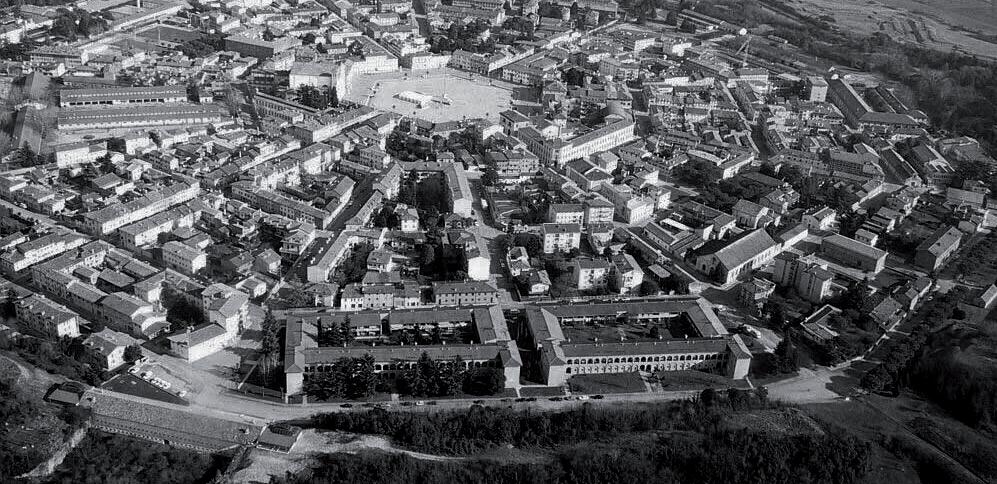
187
Renaissance Star Fort | Palmanova | Vincenzo Sarmozzi
188
Area (km2) = 13.32 x 11 = 146.52
Area Coverage = 146.52 / 710.3 x 100% = 20.63%
Population = 5400 x 11 = 59,400
Density (pers/km2) = 405.405
Density: 405 pers/km2, Palmanova
189
11 Palmanova
190
Area (km2) = 13.32 x 61 = 812.52
Area Coverage = 812.52 / 710.3 x 100% = 114.39%
Population = 5400 x 61 = 329,400
Density (pers/km2) = 405.405
Density: 405 pers/km2, Palmanova
191
61 Palmanova
192
Broadacre City, Frank Lloyd Wright

A suburban concept proposed by Frank Lloyd Wright, he conceived a vision where every family (5 members) would be given 1 acre (4,000m2) plot of land

Area(km2) = 10.24
Population = 5,000
Density(Pers/km2) = 488
Description: Residential lot would be divided into 165ft x 264ft (50x80m), 12 x 15 storey towers housing 33 apartments each, and everywhere is within walking distance. Automobiles are only used to travel from one city to another.
Density: 488 pers/km2, Broadacre City
193
194
250 Broadacre City
Area (km2) = 10.24 x 250 = 2560
Area coverage = 2560/710.3 x 100% = 360.41%
Population = 5,000 x 250 = 1,250,000
Density (Pers/km2) = 488
Density: 488 pers/km2, Broadacre City
195


196


197
Cite Industrielle
Density: 2187 pers/km2,
198 RESIDENTIAL Area 5.67 sq km % of area to total site 35.4% INSTITUTION School 0.68 sq km Laboratories 0.35 sq km Hospital 0.55 sq km Total 1.58 sq km % of area to total site 9.9% INDUSTRIAL Metallurgy factory 6.04 sq km Fabrication factory 1.64 sq km Mining 0.29 sq km Textile factory 0.15 sq km Others 0.04 sq km Abbattoir 0.09 sq km Total 8.25 sq km % of area to total site 51.6% VILLE Area % of residential hospital factory schools abbattoir
Cité Industrielle
Integrating residence, factories, schools, hospitals into a city, the plan allows for expansion of each zone to occur.
A variety of low-density housing is provided, emphasizing the horizontality of this scheme.
Area (km2) = 16
Population = 35 000
Density (pers/km2) = 2187.5
199
1 : 60000
VILLE ANCIENNE 0.32 sq km area to total site 2% factory factory mining schools
laboratories Density: 2187 pers/km2, Cite Industrielle
ville ancienne
200
Area (km2) = 16 x 11 = 176
Area Coverage = 198 / 710.3 x 100% = 24.78%
Population = 35,000 x 18 = 630,000
Density (pers/km2) = 2187.5
Density: 2187 pers/km2, Cite Industrielle
201
11 Cité Industrielle
202
22 Cité Industrielle
Area (km2) = 16 x 22 = 352
Area Coverage = 352 / 710.3 x 100% = 49.56%
Population = 35,000 x 18 = 630,000
Density (pers/km2) = 2187.5
203


204
Density: 5000 pers/km2, Mirage City


205
MIRAGE CITY, ARATA ISOZAKI
ARATA ISOZAKI- MIRAGE CITY, ZHUHAI GUANDONG, CHINA
Mainland
Resort development
Residential/Business/ Commercial
206
Central district
Dwellings on the water
Residential/Business/ Commercial
Artifical Island
Area= 4km2
Population= 20,000
Density= 5000
Building typology modeled after ‘ke jia’ and ‘si he yuan’
Density: 5000 pers/km2, Mirage City
207
208 ARATA ISOZAKI- MIRAGE CITY, ZHUHAI GUANDONG, CHINA
12 Artifical Island Population= 240,000
Density: 5000 pers/km2, Mirage City
209
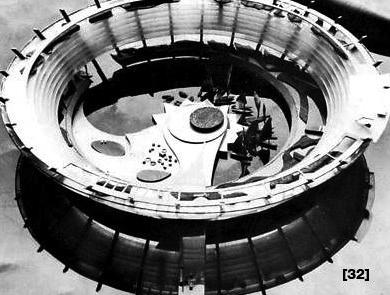

210
Density: 6000 pers/km2, Mesa City


211
MESA CITY, PAOLO SOLERI
PAOLO SOLERI- MESA CITY
Area: 350km2
Total Population : 2,000,000
Density: 5714
Village size: 0.8km2
Village population: 3,000
212
Production/Marketing belt
Refuse/ Regeneration belt
Theological complex
Reservoir
Indigenous village
High-density dwelling
Axial Park
Centre for advanced study
Secondary/primary schools
Ground villages
Density: 6000 pers/km2, Mesa City
213
214
Area occupied: 350km2
Total Population : 2,000,000
Density: 6000 pers/km2, Mesa City
215
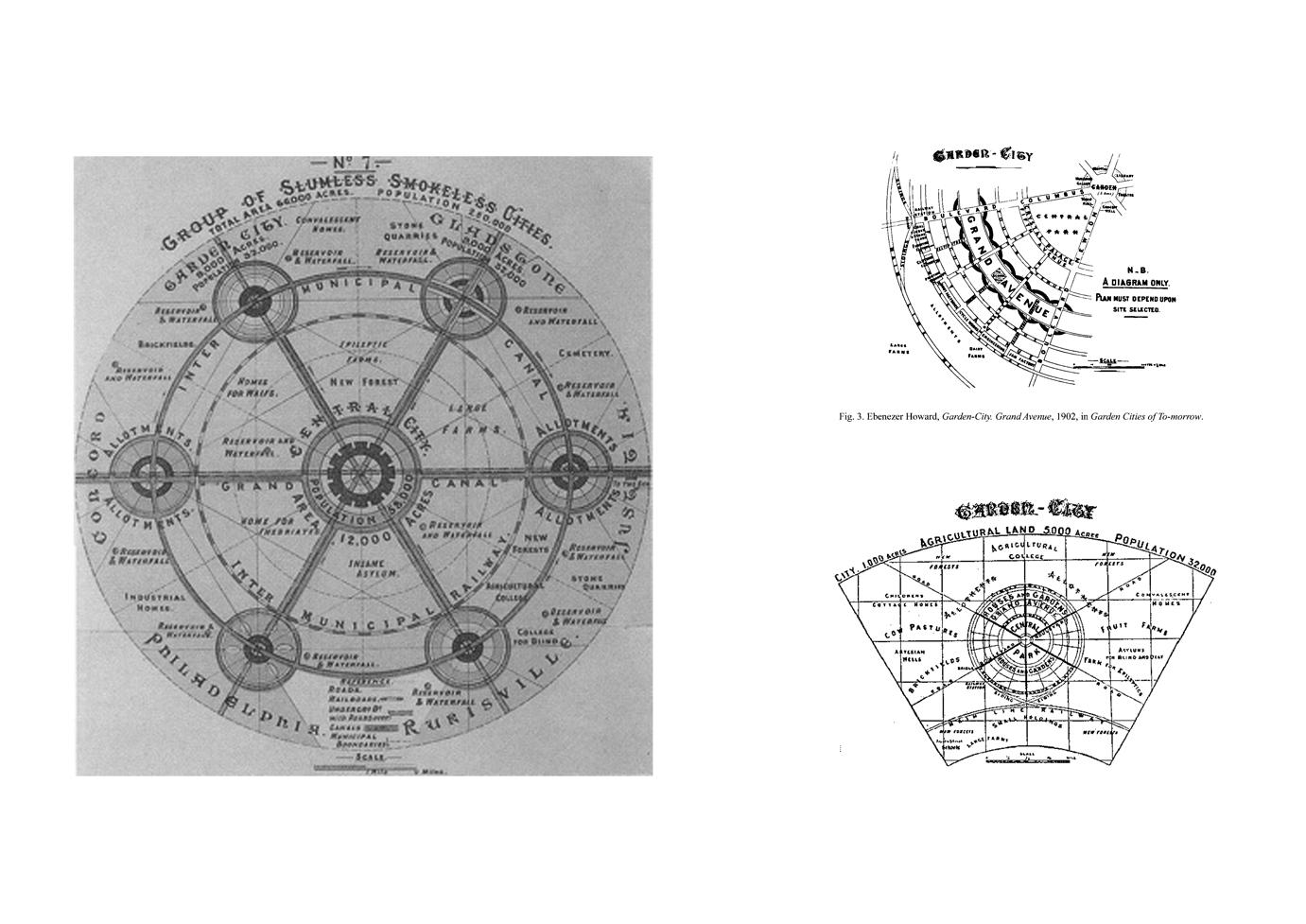

216
Density: 8000 pers/km2, Garden City


218
Ebenezer Howard’s Garden City
Area (km2) = 28 x 4 = 112
Area Coverage = 112 / 710.3 x 100% = 15.8%
Population = 896 000
Density = 8000
Density: 8000 pers/km2, Garden City
219
220
Ebenezer Howard’s Garden City
Area (km2) = 28 x 6 = 168
Area Coverage = 168 / 710.3 x 100% = 23.7%
Population = 1 344 000
Density = 8000
Density: 8000 pers/km2, Garden City
221
222
Ebenezer Howard’s Garden City
Area (km2) = 28 x 10 = 280
Area Coverage = 280 / 710.3 x 100% = 39.4%
Population = 2 240 000
Density = 8000
Density: 8000 pers/km2, Garden City
223
224
Chandigarh, New capital of India
The new capital was designed to accomodate an initial population of 150,000 in its first phase and an ultimate one of 500,000.
Area (km2) = 22.82
Population (as planned) = 500,000
Density(Pers/km2) = 21911
Description = Following a social structure, with the highest paid officla staying nearer to the Capitol. The greater the distance of a sector from the Capitol, the high the density. Population varied from 5,000 to 20,000 people per sector..
Density: 21911 pers/km2, Chandigarh

225
226
10 Chandigarh
Area (km2) = 22.82 x 10 = 228.20
Area coverage = 228.20/710.3 x 100% = 32.13%
Population = 500,000 x 10 = 5,000,000
Density (Pers/km2) = 21911
Density: 21911 pers/km2, Chandigarh
227
228
Area (km2) = 22.82 x 11 = 251.02
Area coverage = 251.02/710.3 x 100% = 35.34%
Population = 500,000 x 11 = 5,500,000
Density (Pers/km2) = 21911
Density: 21911 pers/km2, Chandigarh
229
11 Chandigarh


230
Density: 23073 pers/km2, Paris
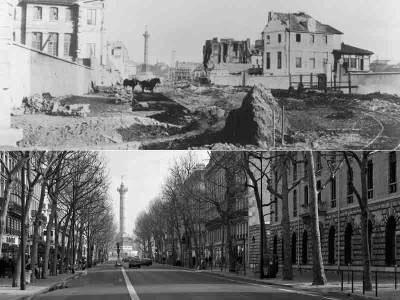

231
19th Century Paris | Baron Haussmann
232
Area (km2) = 86.68 x 3 = 260.4
Area coverage = 260.4 / 710.3 x 100% = 36.6%
Population = 2 million x 3 = 6 million
Density = 23 073.37
Density: 23073 pers/km2, Paris
233
3 Haussmann’s Paris
234
Area (km2) = 86.68 x 4 = 346.72
Area coverage = 346.72 / 710.3 x 100% = 48.8%
Population = 2 million x 4 = 8 million
Density = 23 073.37
Density: 23073 pers/km2, Paris
235
4 Haussmann’s Paris
236
Area (km2) = 86.68 x 10 = 866.8
Area coverage = 866.8 / 710.3 x 100% = 122%
Population = 2 million x 3 = 20 million
Density = 23 073.37
Density: 23073 pers/km2, Paris
237
10 Haussmann’s Paris
238
Brasilia, Capital of Brazi

The city was conceived and planned by Lucio Costa, with an intention to move the capital of Brazil from Rio de Janerio to Brasilia.

Area(km2) = 20.77
Population (as planned) = 500,000
Density(Pers/km2) = 24,073
Description = Being planned for 500,000 inhabitants, Brasilia’s population has grew since several satelite towns were created along the periphery of the city.
Density: 24073 pers/km2, Brasilia
239
240
241 Density: 24073 pers/km2, Brasilia
242
Area (km2) = 20.77 x 9 = 186.93
Area coverage = 186.93/710.3 x 100% = 26.32%
Population = 500,000 x 9 = 4,500,000
Density (Pers/km2) = 24.073
Density: 24073 pers/km2, Brasilia
243
9 Brasilia
244
Area (km2) = 20.77 x 12 = 249.24
Area coverage = 249.24/710.3 x 100% = 35.09%
Population = 500,000 x 12 = 6,000,000
Density (Pers/km2) = 24.073
Density: 24073 pers/km2, Brasilia
245
12 Brasilia
246
Barcelona Eixample
Once Barcelona’s walls were down in 1850,Ildefons Cerdà introduced a grid-iron plan which he named it Exiample, to connect the city with other outlying towns.

Area (km2) = 7.46
Population 2008 = 268,189
Density (Pers/km2) = 35,948
Description = North-west and South-east oriented for maximum amount of sun, light and ventilation. Block sizes 113.3 by 113.3 metres, 12,370 sqm to be built-up, and 800 sqm (0.06%) were to be garden, average 5 to 9 storeys
Density: 35948 pers/km2, Barcelona
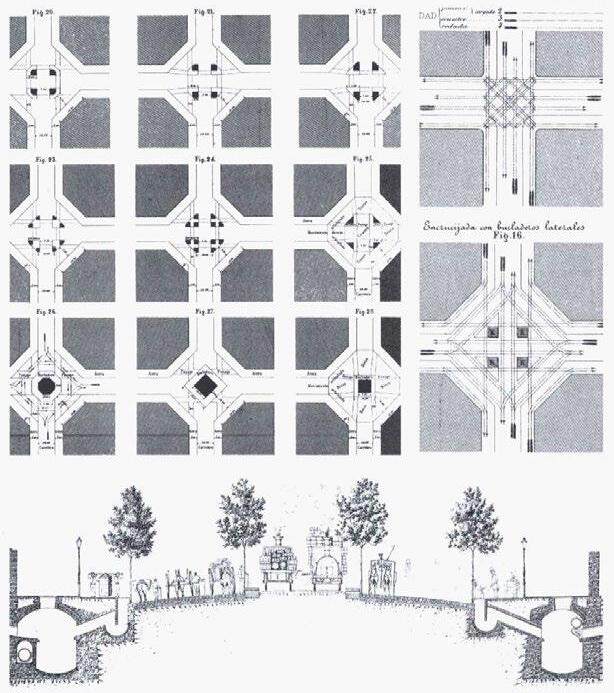
247
248
24 Exiample
Area (km2) = 7.46 x 24 = 179.04
Area coverage = 179.04 / 710.3 x 100% = 25.20%
Population = 268,189 x 24 = 6,436,536
Density (Pers/km2) = 35,950
Density: 35948 pers/km2, Barcelona
249
250
33 Exiample
Area (km2) = 7.46 x 33 = 246.18
Area coverage = 246.18/ 710.3 x 100% = 34.65%
Population = 268,189 x 33 = 8,850,237
Density (Pers/km2) = 35,950
Density: 35948 pers/km2, Barcelona
251
252
39 Exiample
Area (km2) = 7.46 x 39 = 290.94
Area coverage = 290.94 / 710.3 x 100% = 40.96%
Population = 268,189 x 39 = 10,459,371
Density (Pers/km2) = 35,950
Density: 35948 pers/km2, Barcelona
253

Process of Urban Growth
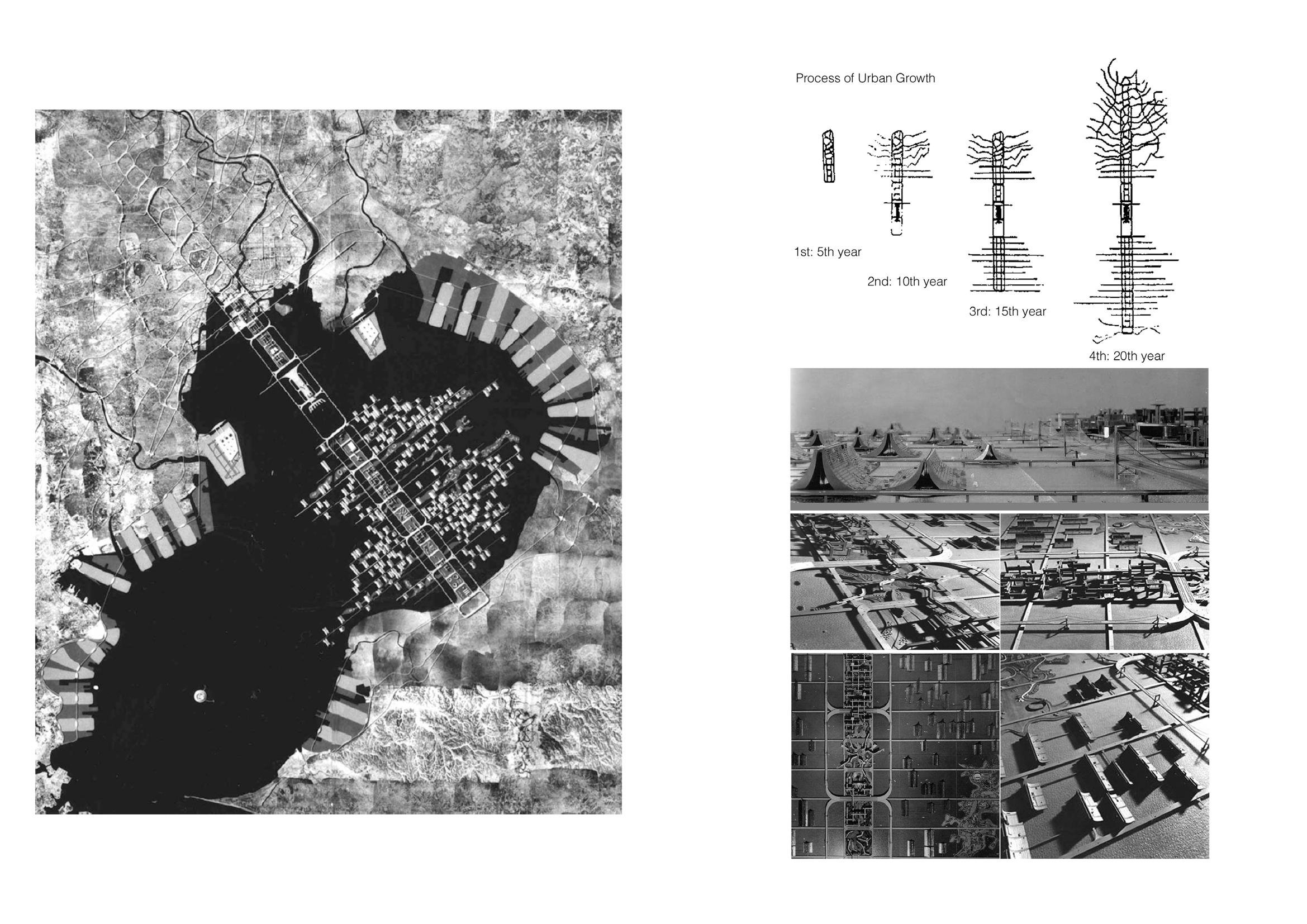
1st: 2nd: 3rd: 4th: Year 5 Year 10 Year 15 Year 20
256
1:250 000
Tokyo
Area (km2) = 275
Population = 10 mil
Density = 36 363.63
Density: 36363 pers/km2, Barcelona
257
Kenzo Tange’s
Bay Project
258
Kenzo Tange’s Tokyo Bay Project
Area (km2) = 275 x 0.65 = 178.75
Area Coverage = 178.75/ 710.3 x 100% = 25.2%
Population = 6.5 mil
Density = 36 363.63
259
Density: 36363 pers/km2, Barcelona
260
Kenzo Tange’s Tokyo Bay Project (Using Singapore’s political boundary)
Area (km2) = 275
Area Coverage = 275 / 1398.3 x 100% = 19.7%
Population = 10 mil
Density = 36 363.63
Density: 36363 pers/km2, Barcelona
261
262
Area (km2) = 275
Area Coverage = 275 / 710.3 x 100% = 38.7%
Population = 10 mil
Density = 36 363.63
263
Kenzo Tange’s Tokyo Bay Project
Density: 36363 pers/km2, Barcelona
264
Area (km2) = 178.75 x 4 = 715
Area Coverage = 715 / 1398.3 x 100% = 51.1%
Population = 26 mil
Density = 36 363.63
Density: 36363 pers/km2, Barcelona
265
Kenzo Tange’s Tokyo Bay Project


266


267 Linear City | Algiers Masterplan | Le Corbusier
Plan Directeur
Density: 40000 pers/km2, Algier
268 RESIDENTIAL Footprint area of each unité 0.0323 sq km Total footprint area 1.5 sq km % of area to total site 5% INDUSTRIAL Heavy industrial area 3.49 sq km Light industrial area 0.44 sq km Merchant port area 0.96 sq km Total 4.89 sq km % of area to total site 15% LEISURE Total area devoted to leisure 2.3 sq km % of area to total site 7% OFFICE Total projected workspace 13.6 sq km % of area to total site 41% GREEN Total verduret area 10.21 sq km % of area to total site 32%
1: 9000
Algiers Plan Directeur
Le Corbusier’s 1942 master plan, a summation of ideas from Obus plans A, B and C, reveals the organisation of Algiers that addresses multi-racial integration and geometrical order. Distributed Unités d’Habitation amidst greenery,limited within 4km radius from city centre at the Casbah. The linear order is imposed by an automobile highway that runs through the coast.
Area (km2) = 32.5
Population (projected) = 1.3 million
Density (Pers/km2) = 40 000
Number of storeys 58
Building height 216 m
Density: 40000 pers/km2, Algier Plan Directeur
269
270
Area (km2) = 32.5 x 5 = 162.5
Area coverage = 162.5 / 710.3 x 100% = 22.87%
Population = 1 300 000 x 5 = 6 500 000
Density (pers/ km2) = 40 000
Density: 40000 pers/km2, Algier Plan Directeur
271
5 Algiers Plan Directeur
272
6 Algiers
(fronting the sea and connected to greater cosmopolis)
Area (km2) = 32.5 x 6 = 195
Area coverage = 195 / 710.3 x100% = 27. 45%
Population = 1 300 000 x 6 = 7 800 000
Density (pers/km2) = 40 000 Density: 40000
273
Plan Directeur
pers/km2,
Algier Plan Directeur
274
8 Algiers Plan Directeur (fronting the sea and connected to greater cosmopolis)
Area (km2) = 32.5 x 8 = 260
Area coverage = 260 / 710.3 x100% = 36. 60%
Population = 1 300 000 x 8 = 10 400 000
Density (pers/km2) = 40 000
Density: 40000 pers/km2, Algier Plan Directeur
275

276
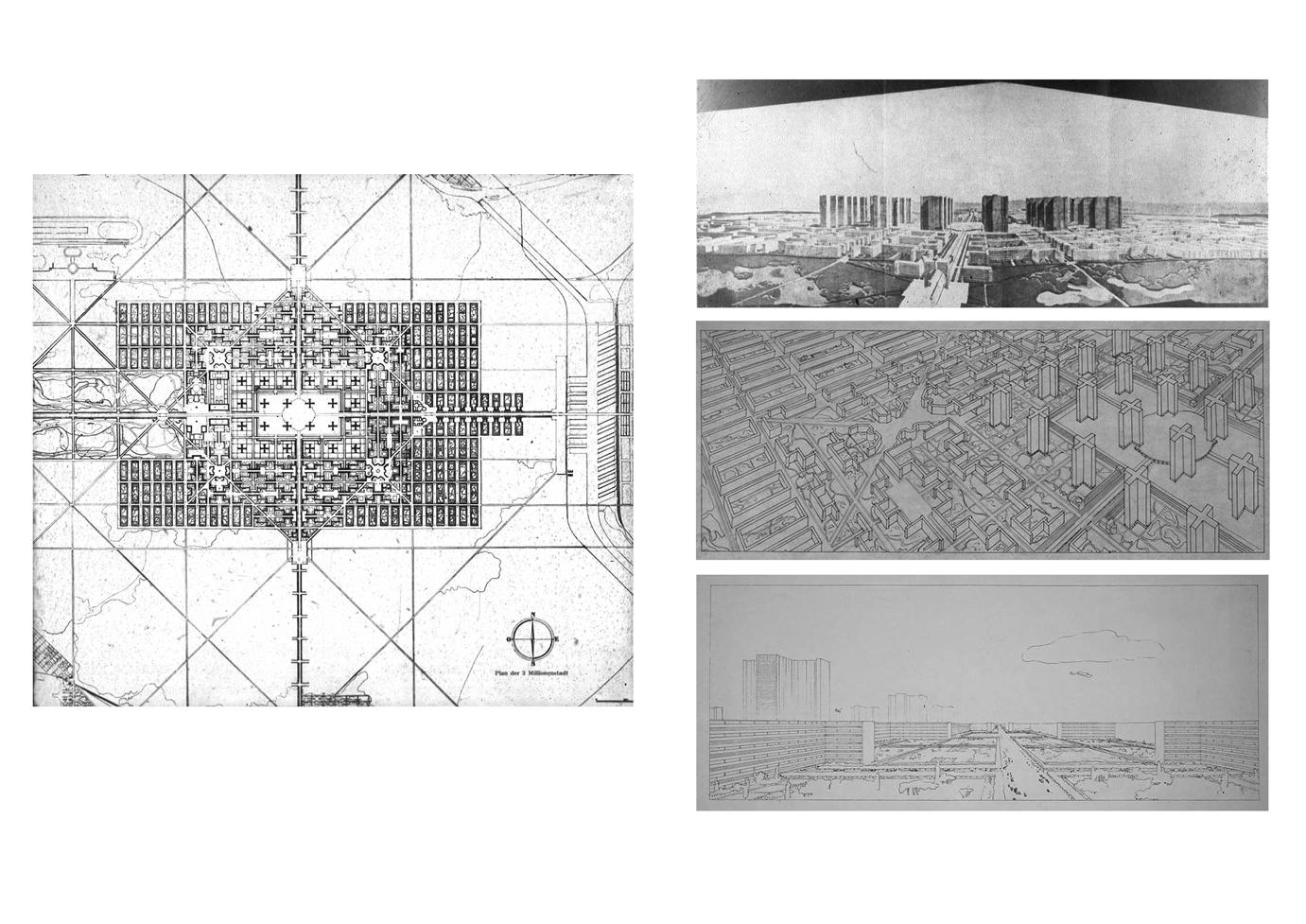

278
Le Corbusier’s Contemporary City for Three Million
Area (km2) = 49.21
Population = 3 million
Density (pers/km2) = 60 963.22
Density: 60963 pers/km2, Contemporary City
279
1:80 000
for Three Million
280
Le Corbusier’s Contemporary City for Three Million
Area (km2) = 49.21
Area Coverage = 49.21 / 710.3 x 100% = 6.9%
Population = 3 million
Density (of precedent model) = 66 043.49
Density: 60963 pers/km2, Contemporary City for Three Million
281
282
2 x Contemporary City for Three Million
Area (km2) = 49.21 x 2 = 98.42
Area Coverage = 98.42 / 710.3 x 100% = 13.8%
Population = 6.5 million
Density = 66 043.49
Density: 60963 pers/km2, Contemporary City for Three Million
283
284
Area (km2) = 49.21 x 6 = 295.26
Area Coverage = 295.26 / 710.3 x 100% = 41.5%
Population = 19.5 million
Density = 66 043.49
Density: 60963 pers/km2, Contemporary City for Three Million
285
6 x Contemporary City for Three Million
286 RESIDENTIAL Total floor area 0.387 sq km % of area to total site 8% HOTEL & RESTAURANT Total 0.097 sq km % of area to total site 2% PUBLIC Total area devoted to leisure 0.338 sq km % of area to total site 7% OFFICE Total projected workspace 4.011 sq km % of area to total site 83%
1: 6000
Algiers Obus Plan A
Obus Plan A includes the linear skyscraper that suggests a dimension for the housing provided under the viaduct (that was later replaced by the highway).
Area (km2) = 0.237
Population = 62 976
Density (Pers/km2) = 265 722
Number of storeys 33
Building height 140 m
Building Footprint 0.179 sq km
287
Plan
Density: 62976 pers/km2, Algier Obus
288
56 Linear Skyscrapers
Area (km2) = 0.237 x 56 = 13.27
Area coverage = 20.38 / 710.3 x100% = 1.87%
Population = 62 976 x 56 = 3 526 656
Density (pers/km2) = 265 808
Density: 62976 pers/km2, Algier Obus
289
Plan
290
104 Linear Skyscrapers
Area (km2) = 0.237 x 104 = 24.65
Area coverage =24.65 / 710.3 x100% = 3.47%
Population = 62 976 x 86 = 6 549 504
Density (pers/km2) = 265 808
Density: 62976 pers/km2, Algier Obus
291
Plan
PROBE #4: CONSTRUCTING VISIONS

294
Michael Lee, Butter Building, from the series “Office Orchitect”, 2011 Paperboard 49 x 49 x 79 cm

295
Michael Lee, Rollercoaster Longhouse, from the series “Office Orchitect”,2011 Paperboard, 22 x 49 x 79 cm

296
Michael Lee, Csengi Prism, from the series “Office Orchitect”, 2011
Paperboard 49 x 49 x 79 cm

297
Michael Lee, Petronas, from the series “After Humans”, 2011 Giclée on archival matt paper, 52.5 x 42 cm

298
Michael Lee, Cropped City (after M Night Shyamalan), from the series “Second-Hand City”, 2011 Paperboard 49 x 49 x 79 cm
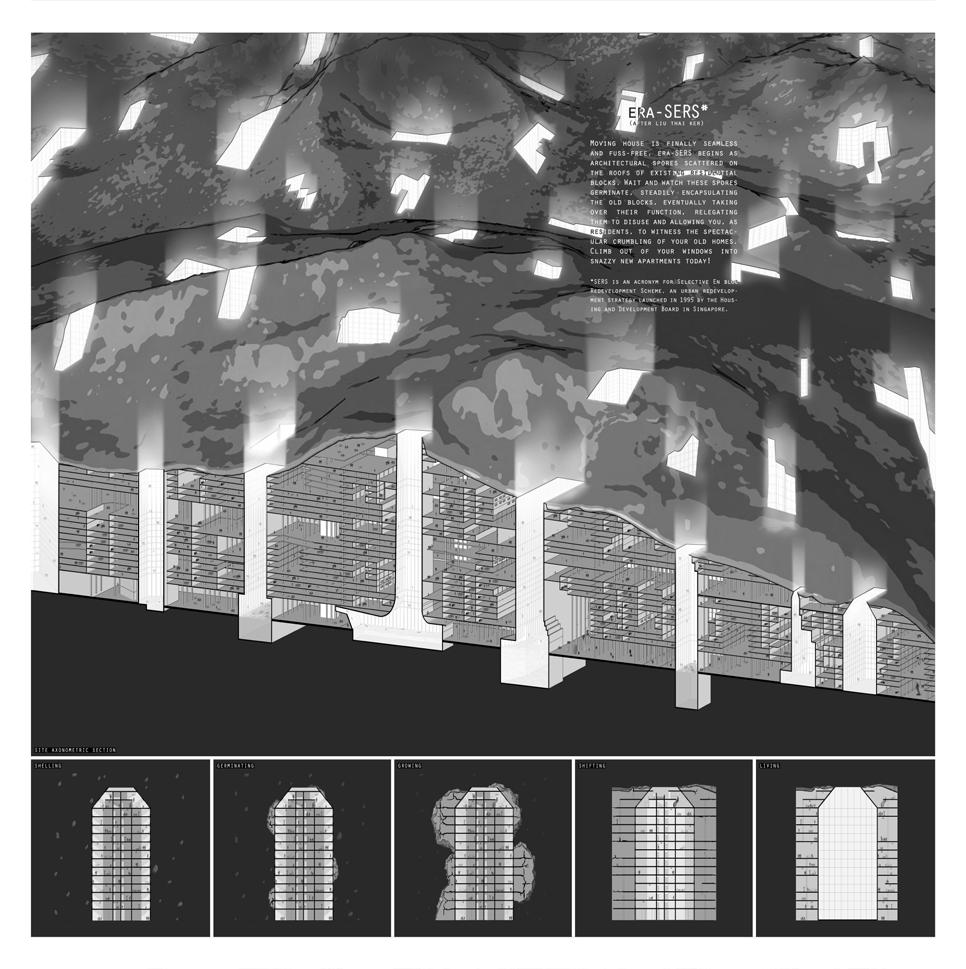
299
Michael Lee, era-SERS (after Liu Thai Ker), from the series “Second-Hand City”, 2010 Giclée on archival matt paper, 123 x 123 cm
300
HYDROPOLIS
by Eudora Tan Ee Teng
Singapore contends not only for land but also for freshwater to feed the thriving population of 5 million and counting. Water storage is an eminent lack of the nation and forces a dependency on neighbouring resources to supply its needs and in the recent decade, on high technology to refine used water for drinking. With a tropical locale that promises heavy rainfall of about 1600 mil m3 each year, its inability to retain its precipitation volume also threatens the urban landscape and its infrastructure. The thesis observes an imminent crisis of the sustainability of Singapore’s water provisions and postulates an alternative morphology of the city to capitalise on the nation’s only natural resource – the rain. It then reconsiders how the urban morphology may be conceived and engaged with to optimize water storage.
Singapore is, historically and physically, a water state, as are water cities such as Venice and Amsterdam. Yet the proximity and engagement with water within the Singapore urban fabric is limited and dismissed as a purchased product out of pipes and taps. The thesis imagines the alternative landscape as one that allows water to seep into the urban fabric, and be retained, replacing existing road-drain infrastructure with a system of variegated waterways teeming with life. With water retention as primary strategy, the intervention is an incision into the city, taking the 54 sq km of roads and drainage canals to serve as water storage.
The alternative hydrology of the city drives this surgical tabula rasa, bringing a two-tiered system of transport canals at lower topography and aqueduct circuits above to channel or withhold water collected at higher topographies. Previously subsumed only into pipes and dissolved into gutters, water resurfaces as Singapore’s nouveau identity as it actively engages with the city as transportation channels, wetland park, recreational pools, bridge etc.
The new garrison state city of Singapore is at once confronted by the sheer monstrosity of its own consumption yet this hydropolis promises a landscape of water sovereignty, ecology and sustainability – Singapore’s much desired dominion over hydrology, discipline over nature, her fulfilled vision of the clean, green and blue.
301
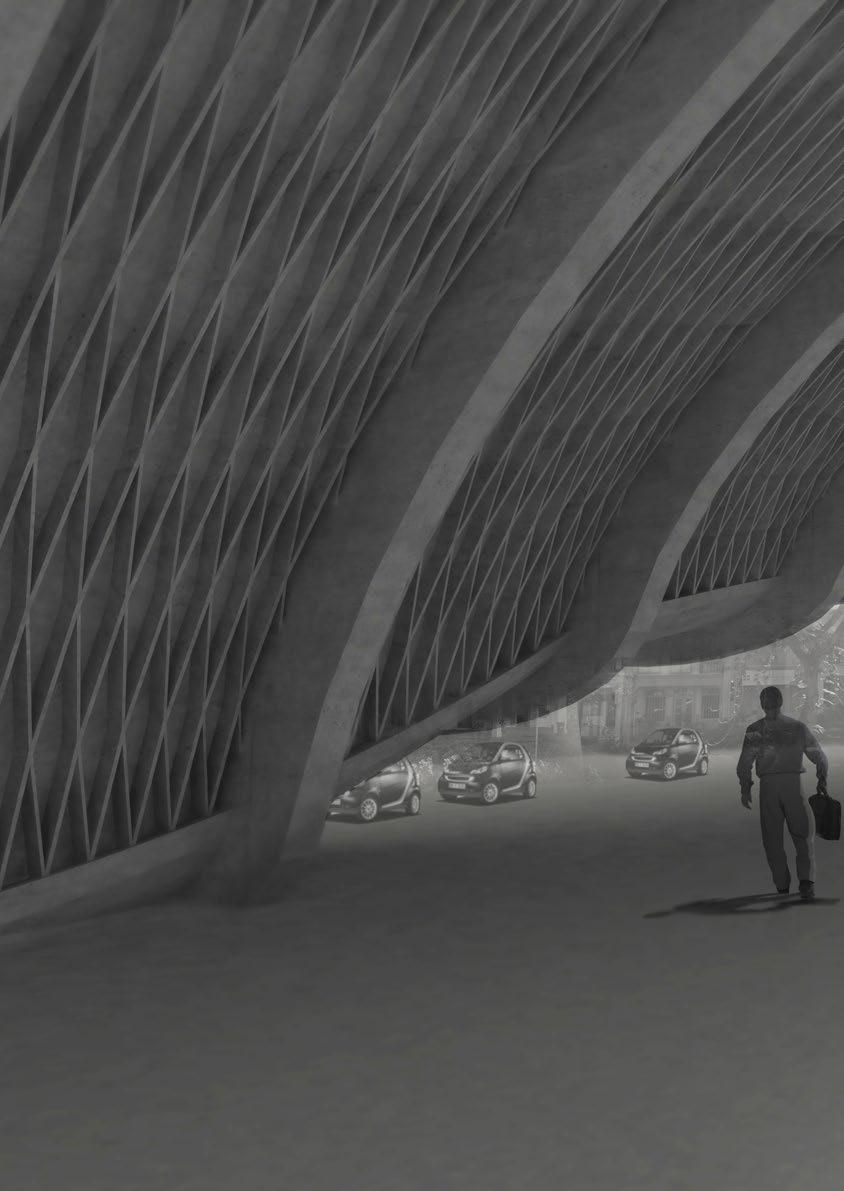

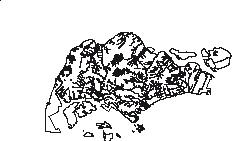
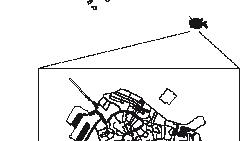
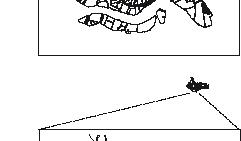

304
305



306
307 New waterways <5m, 17.22km2 x 6m = 103,000,000 m3
308 5m < aqueducts < 20m, 13.38km2 x 15m = 200,000,000 m3
309 Waterways + Aqueducts <20m, 103 + 200 = 303,000,000 m3
310 303 + 16.2 + 155.64 = 474,840,000 m3


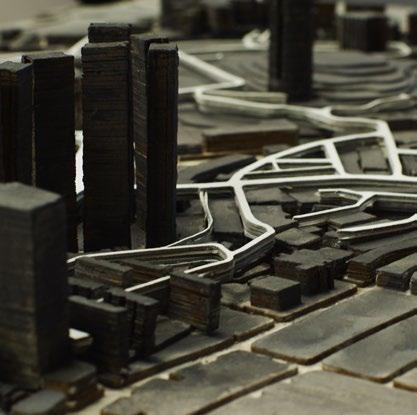
311


312


313



314



315

316

317

318 multilayer biomesh island matrix exposed roots for nutrient uptake wetland vegetation 2100 15000 maximum flood level aqueduct storage level (high rainfall) aqueduct storage level (low rainfall) estimated drought level vertical collection pipe settlements inlet port filtration pump 20350

319 CL 40000 3400 50mm reinforced concrete topping steel ‘L’ angle plate 15mm thk steel ‘L’ angle plate 15mm thk 2100mm deep concrete pile cap 750mm steel pipe pile, open end, concrete-filled steel ‘I’ channel tapered beam 900mm deep concrete slab on trapezoidal galvanised steel decking


320

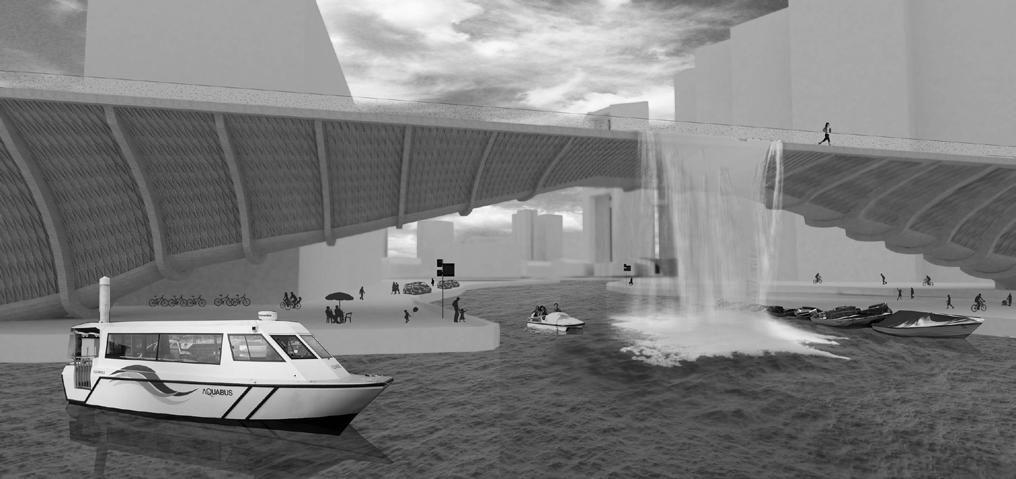
321
322
TETRIS CITY
by Felicia Toh Wei Ching
Singapore has conventionally been masterplanned in line with Tony Garnier’s Cite Industrielle influences, which segregates a city into disparate urban functions on a horizontal plane. This results in the death of the street at certain times of day, because activity and occupation is not continuous but a series of interrupted pulses by a single dominant program. Shenton Way is a good example of this.. This thesis proposes an anti-masterplan approach which generates a city from the bottom up. Diversity of programs are encouraged to thrive within a 1km by 1 km square, to allow pollination of influences amidst the congestion. Sited on Marina Bay, Singapore’s prime financial and commercial district, this landscape of extreme diversity is a melting pot for entrepreneurship and an authentic street culture to arise.
There are several strategies proposed to achieve this. A Diversity Calculator and Spread Calculator encourage Developers firstly, to sell their GFA to diverse program owners, and secondly, to embed these programs throughout the building in interesting permutations, instead of classifying similar programs into a typical podium-mall typology.
Space is sold differently in Tetris City. Instead of conventionally selling space only on a horizontal plane, program owners have the freedom to determine the volumetric configurations of the space they need. For instance, factory owners can have higher ceiling heights for the placement of chutes and lower heights elsewhere for their assembly area. A theatre owner can also determine the height of his proscenium relative to the foyer. These different programs stack atop each other, creating gaps where courts, gardens and light can filter into the block. This allows the city to develop through micro growths instead of top down from a master-plan. It is a city of aggregation, not one of imputation and amputation.
Tetris City is imagined as the antidote to Singapore’s sterility. It is based on micro growth, not a master plan, which allows life in its various forms to bubble up from the ground up in unconventional and unrestricted ways. as Manhattan has its Meat-Packing District and Tokyo has Harajuku, perhaps every city needs a little chaos; its own edge of signature quirk. Tetris City is envisioned as a landscape of extreme difference encapsulating all the desires and energy of its inhabitants.
323
324 Factory Lodging Digital Electronics Business Social Civic
325 Civic Health Retail Pleasure F&B Education Services
326
327
328
329
330
331


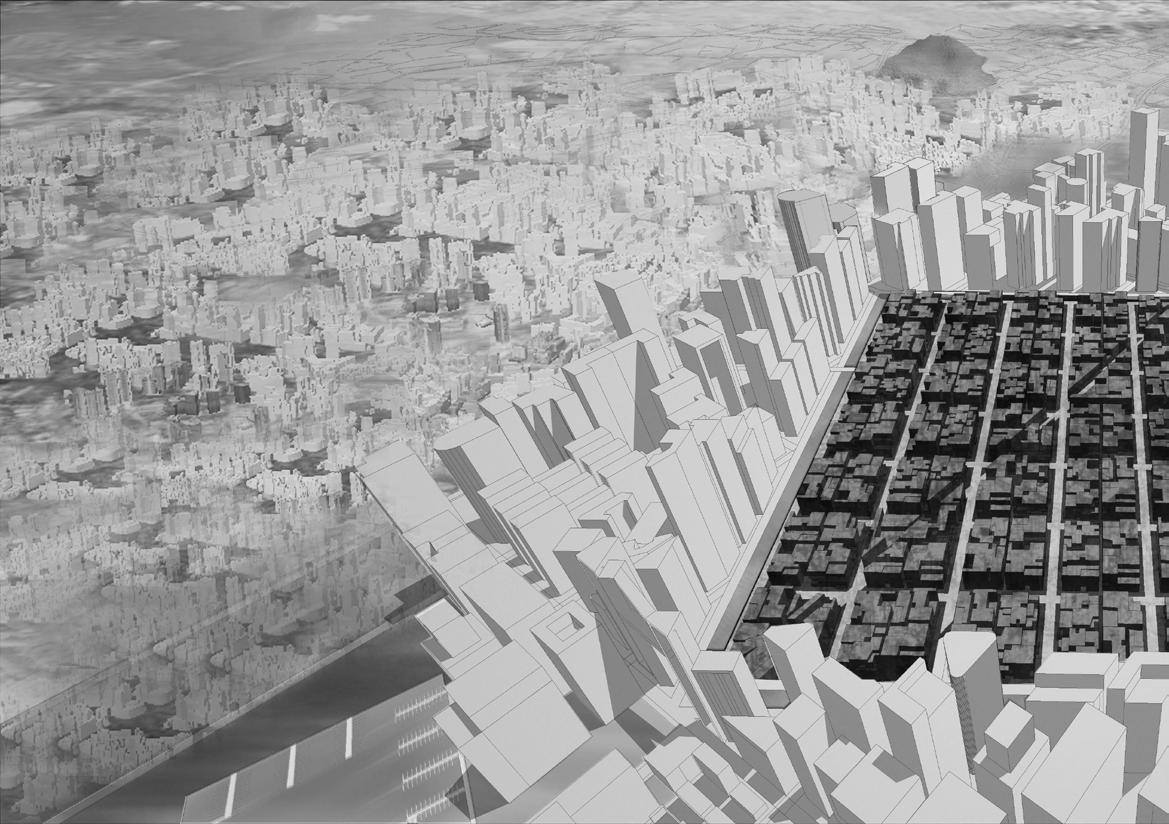
334

335

336

337
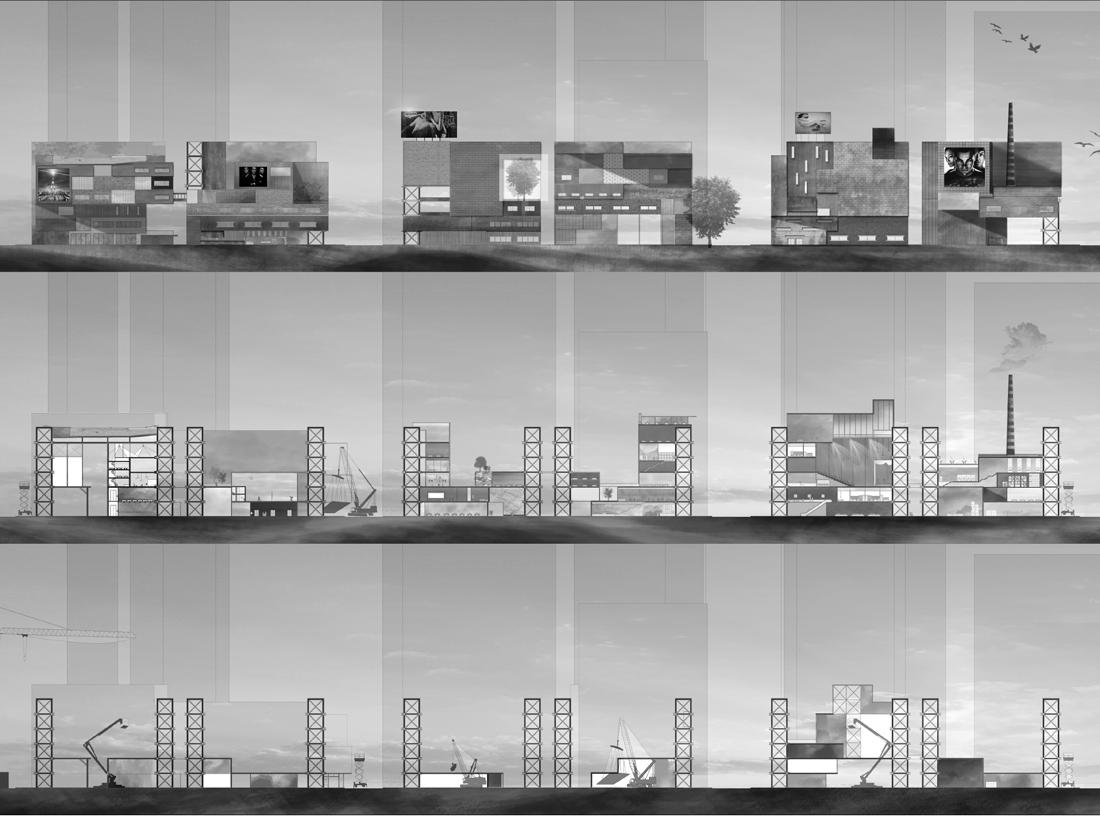


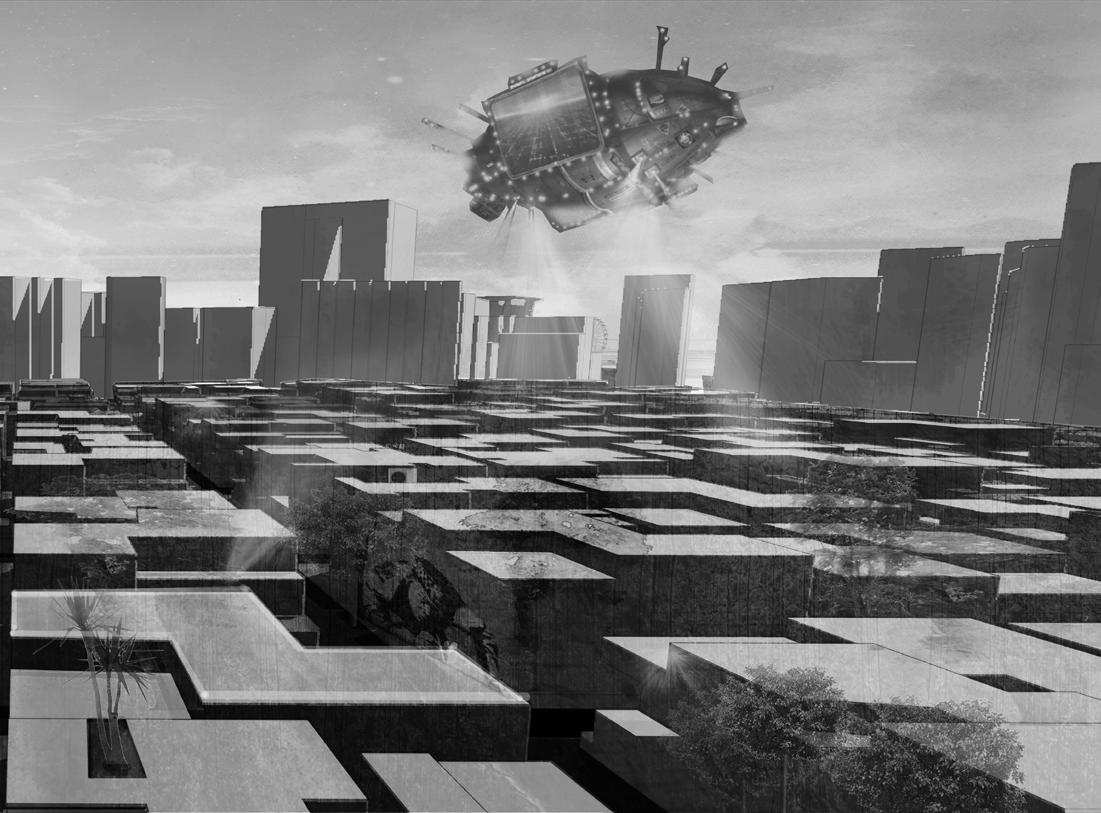


340



342

343
344
by Tan Bing Hui
From the Greek sitos which means food, and topos for place, so it means ‘food-place’. As opposed to utopia (‘good place’, or ‘no place’) a term used since Plato to describe an ideal and therefore unattainable community, utopia is the nearest thing to a cross-disciplinary tradition of thought about the problem of dwelling, city planning and architecture. However, utopia is usually an unrealistic approach because of its aim and intention to attain perfection. Contrary to that, Sitopia is a practical alternative
- Carolyn Steel, Hungry City: How food shapes our lives
Sitopia has formulated a methodology of imagining and manifesting a new form of configured productive landscape through the concept of agrarian urbanism. This new model will integrate the autonomy of agriculture into the contemporary urban landscape, and will become a guiding principle for strategic and purposeful architectural operation on shaping the earth and to consider the correlation of inhabitants and the land, vegetation and the hydrological cycle. The intent is to manifest a multi-functional environment which will include agriculture, markets, stores and most importantly, for its aesthetics and visual attractive-ness. In this vision, inhabitants not only feed themselves, but are also given a direct stake in building a cohesive nation, society and communities based on food in sustaining the nation of Singapore and the population through participating in resource management by reducing energy consumption, waste, pollution, producing food, and last but not least, re-establishing our relationship with the land.
345
SITOPIA



348

349

350 1960 31.6% 1984 14.8% 2010 1.8% Diminishing productive landscape
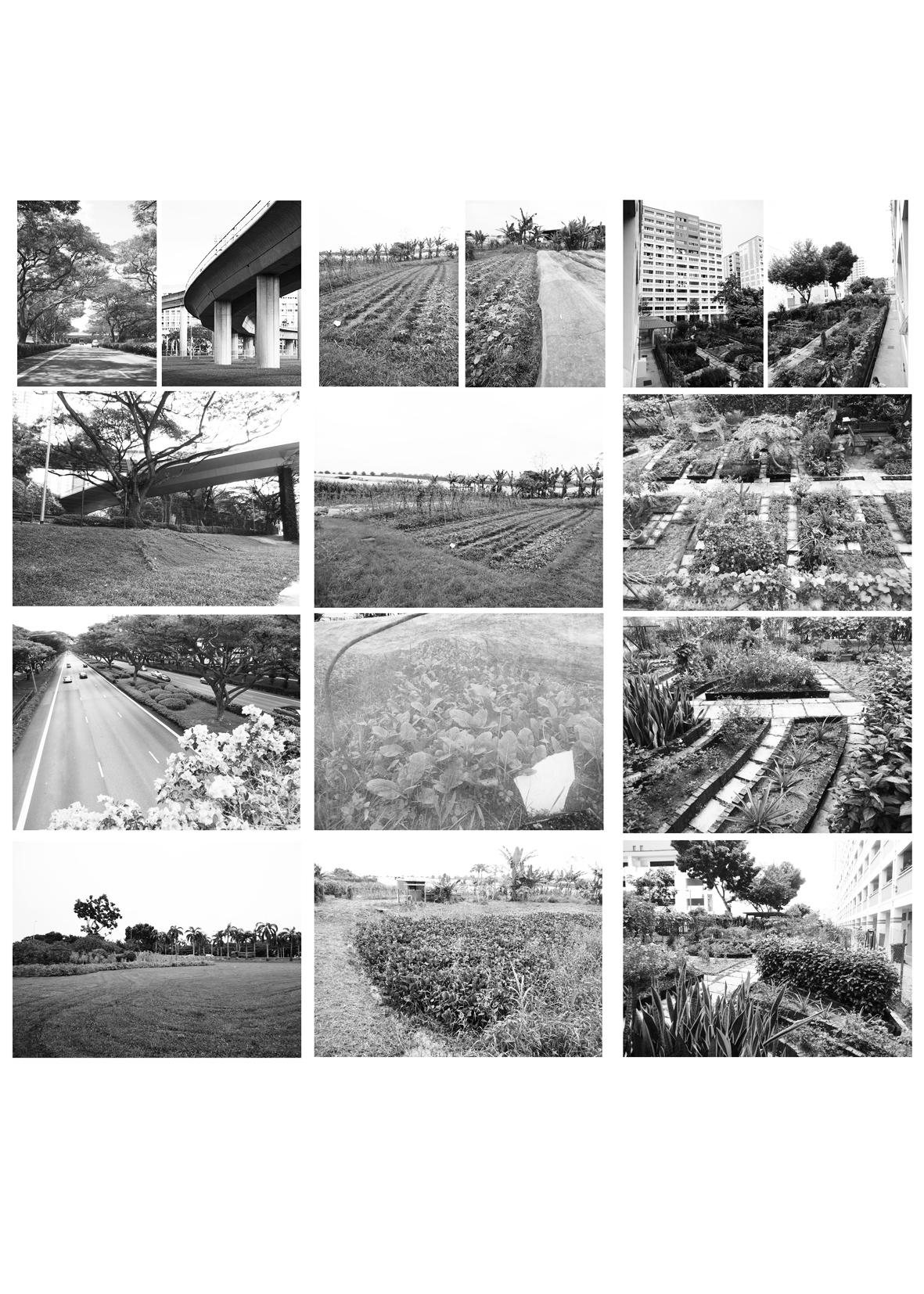
351
Aesthetic Tradition Improvise
352
353 Roads of Singapore, 2011
Expressway
Length: 161km
Setback: 30m
Total Area: 9.66km2
Arterial Roads

Length: 627km
Setback: 15m
Total Area: 18.810km2
Collector & Local Roads
Length: 2567km
Setback: 7.5m
Total Area : 38.505km2
66.975km2, 9.42% of Singapore land area for setbacks
354
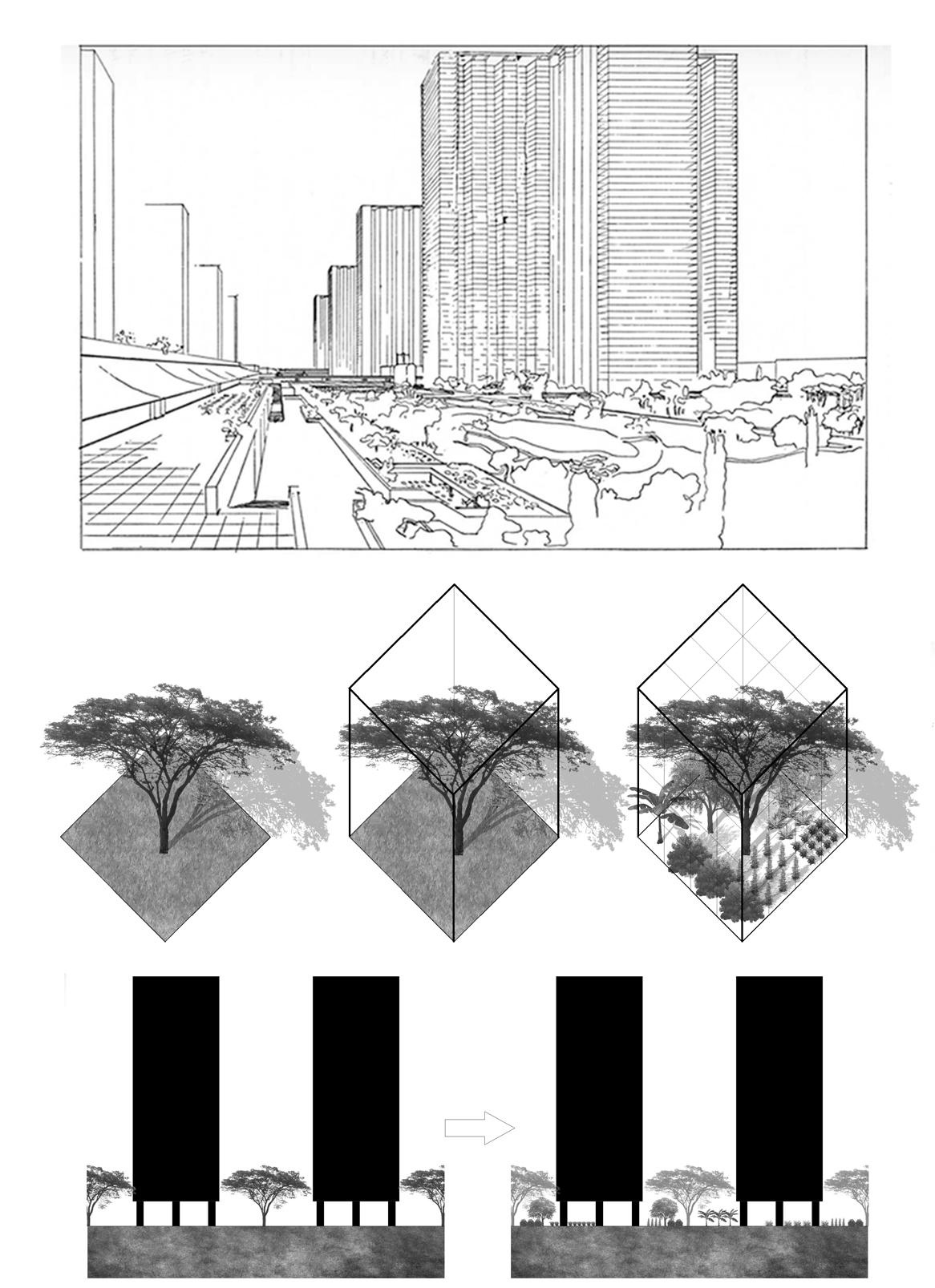
355 Transforming SIngapore’s landscape
Le Corbusier - Contemporary City
GreenBufferRoadSetback
356 Phasing transformation

357

358 300 x 300 150 x 150 100 x 100 75 x 75
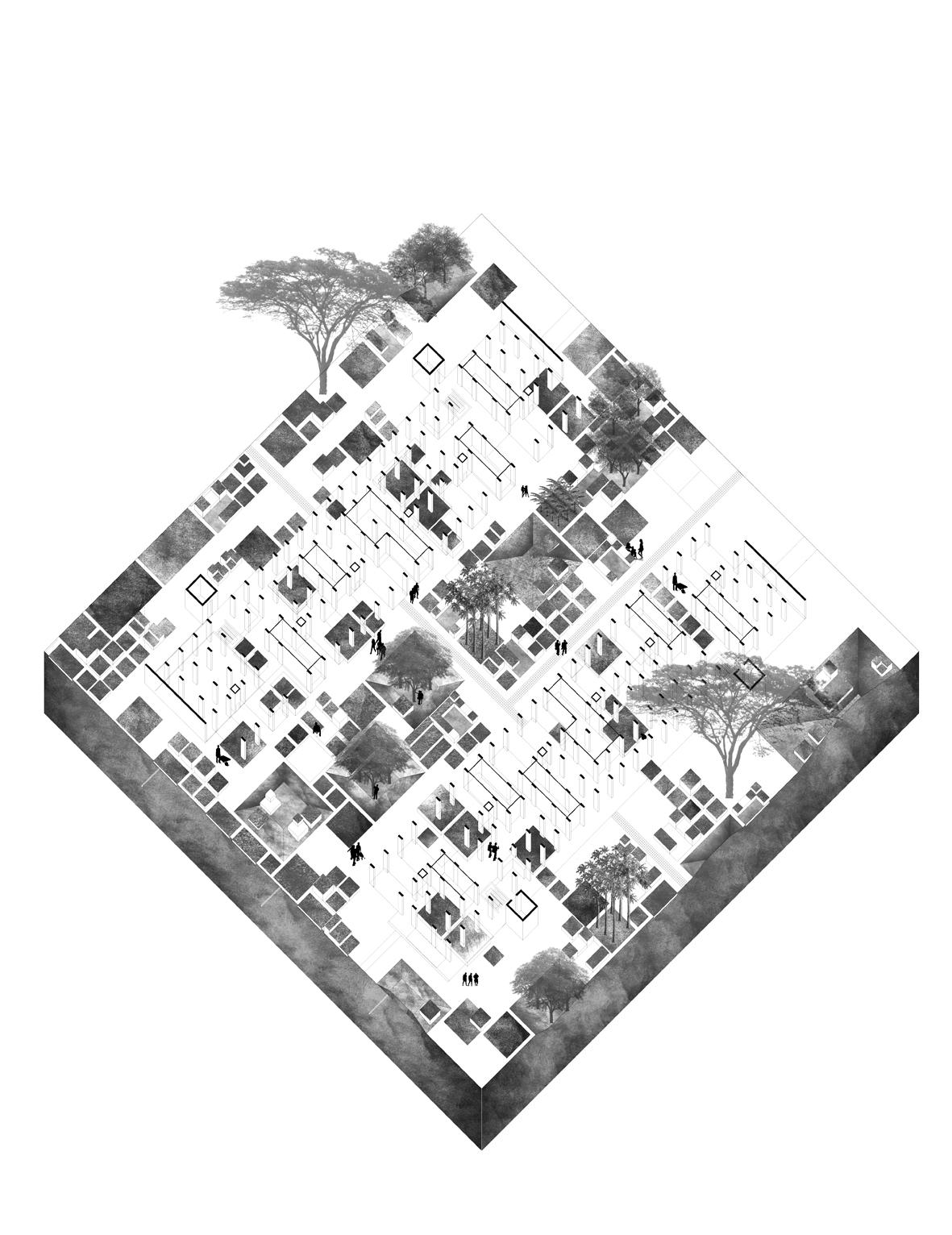
359

360
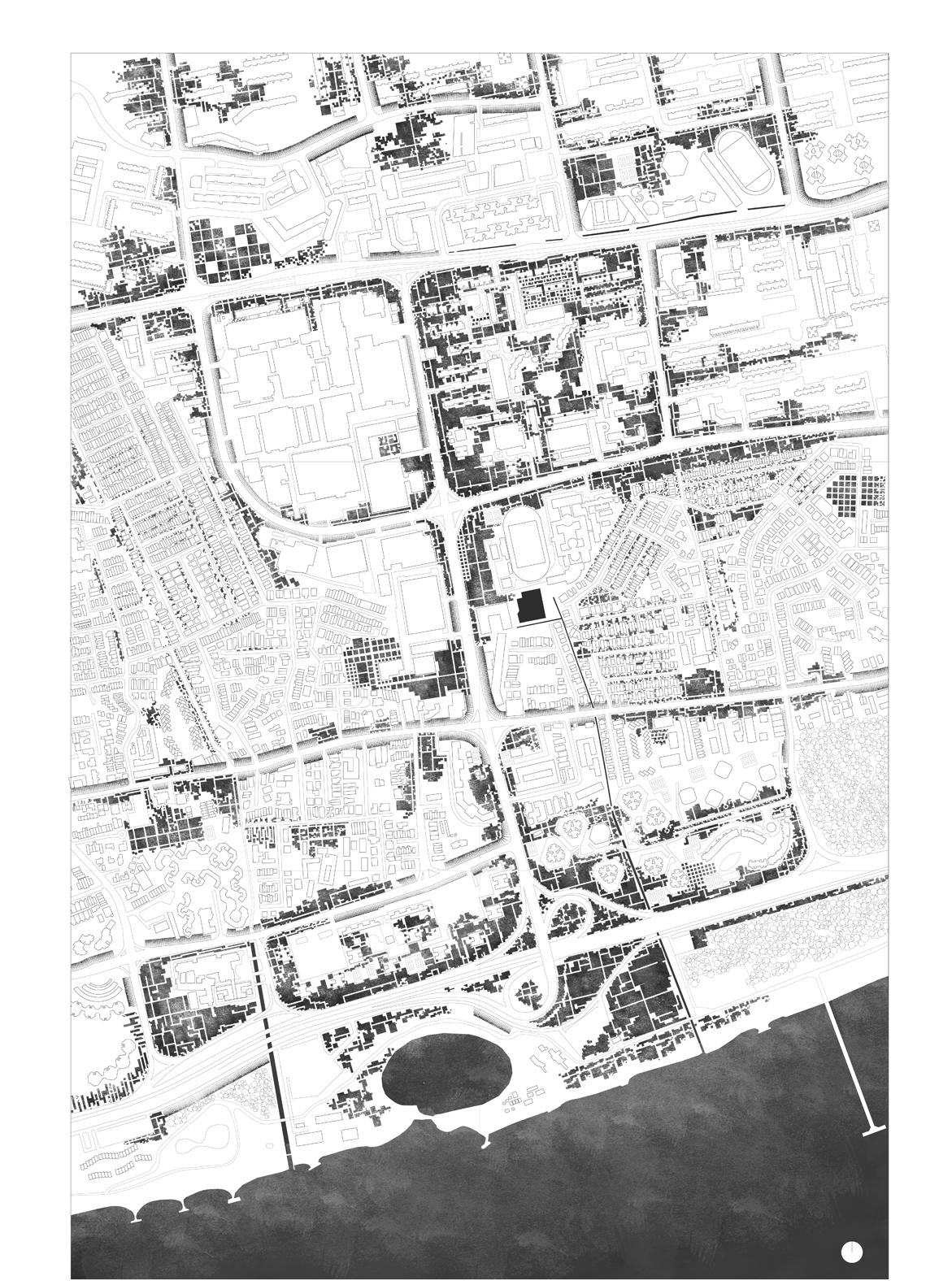
361

362

363
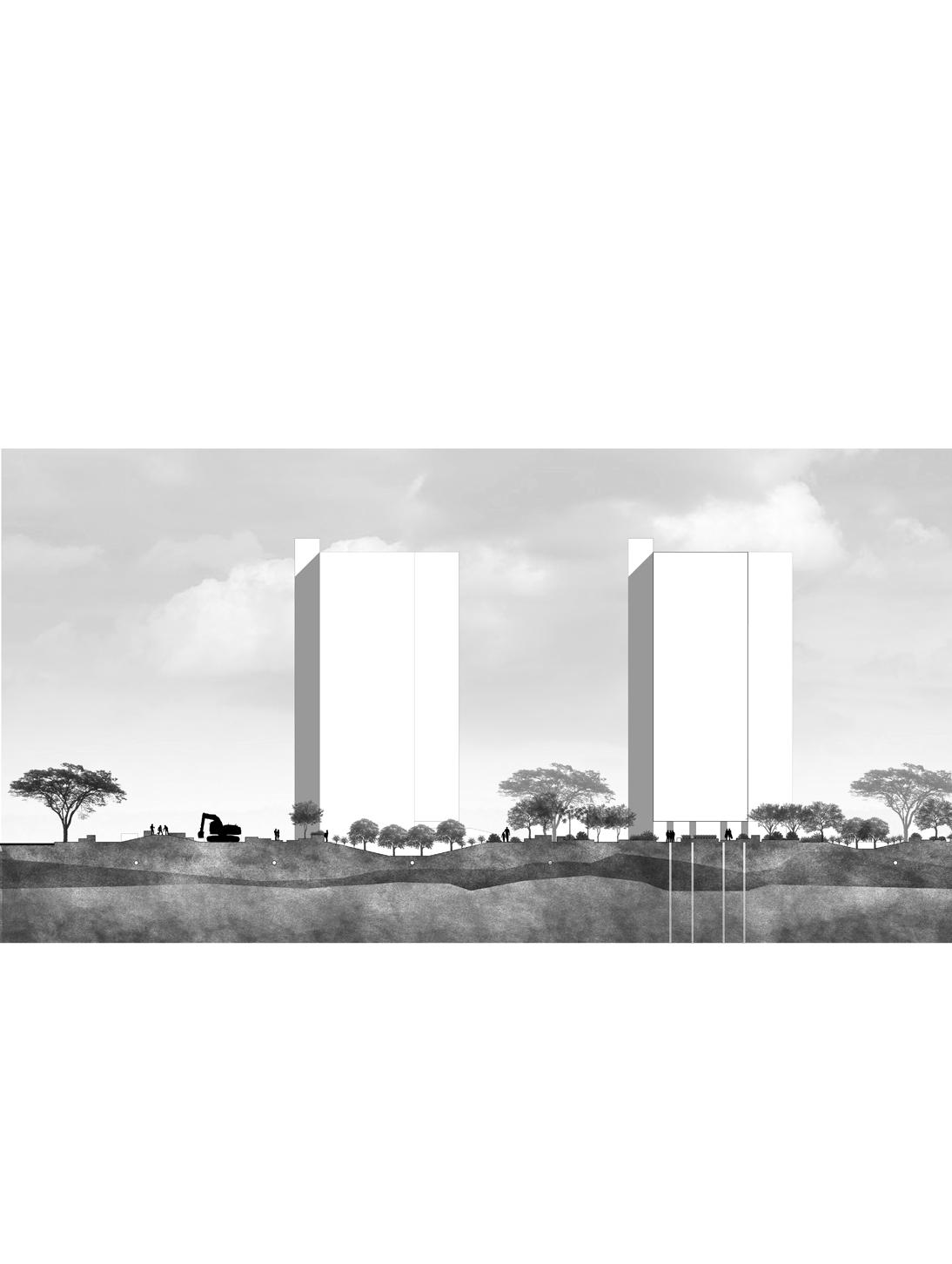
364

365






























































































